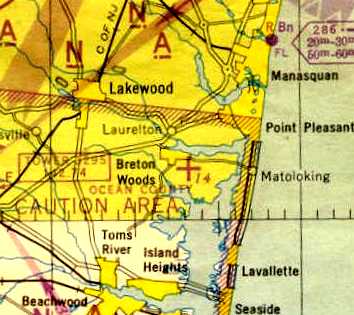
Abandoned & Little-Known Airfields:
Eastern New Jersey
© 2003, © 2016 by Paul Freeman. Revised 8/12/16.
This site covers airfields in all 50 states: Click here for the site's main menu.
____________________________________________________
Please consider a financial contribution to support the continued growth & operation of this site.
Colts Neck Airport (revised 12/20/15) - Lakehurst NAS (revised 8/12/16) - McGuire AFB BOMARC Missile Site (revised 3/22/14)
Ocean County Airport / Huppert’s Airport / Osbornville Airport (revised 4/24/14) - Preston Airport / Marlboro Airport (revised 2/26/16) - Red Bank Airport (revised 2/25/16)
Schlossbach Field / Asbury Park Neptune Air Terminal (revised 8/12/16)
____________________________________________________
Ocean County Airport / Huppert’s Airport / Osbornville Airport, Osbornville, NJ
40.04, -74.114 (South of New York, NY)

Ocean County Airport, as depicted on the 1945 NY Sectional Chart.
Ocean County Airport was evidently established at some point between 1940-45,
as it was not yet depicted on a 1940 aerial photo.
The earliest depiction that has been located of Ocean County Airport was on the 1945 NY Sectional Chart,
which depicted it an auxiliary airfield.

Ocean County Airport, as depicted on the 1947 USGS topo map.

A circa 1940s-50s advertisement for Ocean County Airport's Huppert Aviation Company (courtesy of Gary Fitton).

The 1953 USGS topo map depicted “County Airport” as having 2 unpaved runways.

A 4/22/53 USGS aerial photo depicted Ocean County Airport as having a single northeast/southwest unpaved runways.
Two single-engine aircraft were visible near some small buildings on the northeast side.

A 1953-54 photo by Gary Fitton of a Bonanza & CAP cadet Charles White in front of the Ocean County Airport office & hangar.
Gary Fitton recalled, “Ocean County Airport... one of my teenage hangouts 1953-56, when I was a Civil Air Patrol cadet.
Our unit met here on the weekends. The runway was gravel.
We knew it as Huppert’s, but it was also known as Osbornville Airport, or Ocean County Airport.
These were mostly brand-new airplanes! Off in one of the hangars was a T-50 Bobcat.
My wife lived just off the end of the runway, and often spoke of SNJs from Lakehurst shooting landings, and even the occasional blimp.
She recalls one day when she got to sit in the gondola of one.”

A 1953-54 photo by Gary Fitton of an Ercoupe in front of the Ocean County Airport hangar.

A 2/13/54 newspaper photo of Ocean County Airport's main hangar engulfed in a mass of flames (courtesy of Gary Fitton).
The fire destroyed the main hangar, 10 planes, a shed, and a panel truck.
According to Gary Fitton, “It was probably the beginning of the end for Huppert Aviation & Ocean County Airport.”
A 1956 aerial photo depicted Ocean County Airport in the same physical configuration,
but no aircraft were visible on the field.

The last aeronautical chart depiction which has been located of Ocean County Airport was on the 1957 NY Sectional Chart.
It depicted Ocean County as having a 2,700' unpaved runway.
Ocean County Airport was evidently closed at some point between 1957-63,
as a 1963 aerial photo depicted houses covering the site.

A 9/21/10 aerial view shows the site of Ocean County Airport covered with houses.
The site of Ocean County Airport is commemorated via all of the street names of the neighborhood which replaced it:
Huppert Drive, Sky Manor Boulevard, Boeing Drive, Lockheed Road, etc.
And the park to the west of the airport site is labeled as the “Joe Pal Airport Property”.
____________________________________________________
McGuire AFB BOMARC Missile Site, New Egypt, NJ
40.034, -74.441 (Southwest of New York, NY)
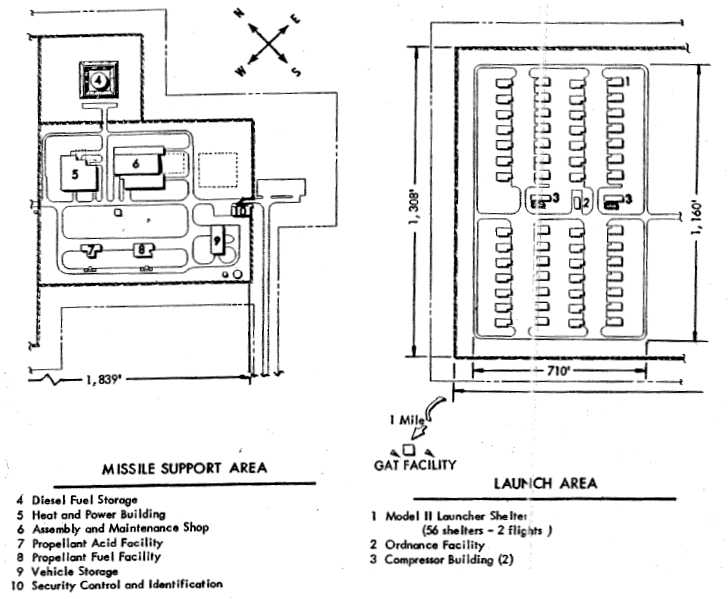
The layout McGuire BOMARC Missile Support Area & Launch Area,
from the 12/3/59 Boeing “IM-99A Bases Manual”,
showing the facility in its original configuration with 56 individual BOMARC A missile launch buildings.
The purpose of this military base was to shoot down incoming aircraft.
It is included here due to its significance in Cold War history,
and its remarkable state of preservation.
This site was one of a network of 8 BOMARC sites spread around the nation.
The others were located at Dow AFB, ME, Suffolk AFB, NY, Otis AFB, MA, Langley AFB, VA,
Niagara Falls, NY, Kinchloe AFB, MI (Raco AAF), and Duluth IAP, MN.
Although designated the "McGuire AFB BOMARC site",
the installation is well to the east of the Air Force Base.
It actually sits just off the end of the primary runway of the Lakehurst Naval Air Test Facility, just east of NJ Route 539.
The Mcguire BOMARC installation was not yet depicted on the 1957 USGS topo map.
The McGuire installation was the Air Force's first operational BOMARC missile installation.
Construction began in January 1958 and took nearly 2 years to complete.
The Philadelphia District of the Corps of Engineers supervised construction
of the 56 Model II shelters (each of which housed a single IM-99A BOMARC missile on a launcher) & ancillary buildings.
The site was declared operationally ready on 9/1/59,
manned by the 46th Air Defense Missile Squadron.
The earliest depiction which has been located of the McGuire BOMARC installation
was a diagram of its Missile Support Area & Launch Area,
from the 12/3/59 Boeing “IM-99A Bases Manual”.
It depicted the facility in its original configuration with 56 individual BOMARC A “Model II Launcher Shelters”.
The Ground-to-Air Transmitter site which provided missile guidance was depicted one mile to the northwest.
However, according to the Air Defense Command historian,
the declaration of the McGuire BOMARC site's “operational readiness” in late 1959 severely strained the concept of the term.
As late as December, the facility hosted only 1 ready missile.
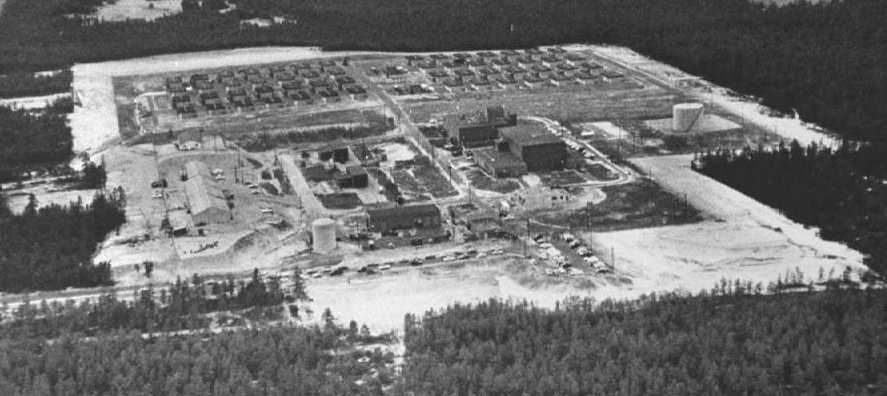
The earliest photo that has been located of the McGuire BOMARC site was a June 1960 aerial view looking north,
in its original configuration with 56 individual BOMARC A missile launch buildings along the north side of the installation.

An undated photo of 4 BOMARC missiles elevated into launch position at McGuire.
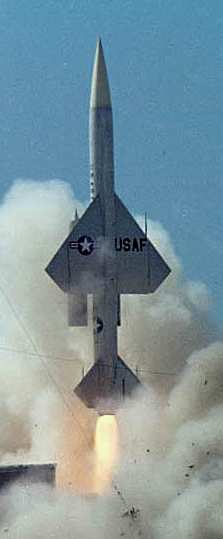
Undated photo of a BOMARC launch.
The BOMARC missile was huge: each one stood 45 feet tall & weighed 16,000 pounds.
More than 40 years after its deployment, it still holds the record for the longest range of any surface-to-air missile ever developed: 440 miles.
It also had a maximum speed of nearly Mach 4.
The McGuire BOMARC site was made infamous as the site of a radioactive material spill.
The incident happened on 7/7/60, according to the book “U.S. Nuclear Weapons: A Secret History”, by Chuck Hansen.
A nuclear-armed BOMARC missile in ready storage condition (permitting launch in 2 minutes) in missile Shelter 204
was destroyed by explosion & fire after a high pressure helium tank exploded & ruptured the missile's fuel tanks.
The warhead was also destroyed by the fire although the high explosive did not detonate.
Plutonium fragments from the warhead were spread over an area surrounding the launcher.
The firefighting efforts around the missile building resulted in contamination being washed into the soil & a nearby stream.
All identifiable fragments of the warhead were recovered,
but the surrounding soil in the site has remained in a low level radioactive state for over 40 years.

An undated photo of the remains of McGuire BOMARC missile Shelter 204,
showing the damage caused by the July 7, 1960 missile explosion.
By October 1962, McGuire's 1st generation BOMARC IM-99A missiles
were superseded by the 2nd generation BOMARC IM-99B variant.
Rather than reconfigure the original Model II shelters to accept the new missile,
the Air Force directed that Model IV shelters be constructed on adjacent property to the north of the original launchers.
The New York District of the Corps of Engineers supervised the construction of these new launcher shelters.

A 1963 aerial view shows the addition of 28 individual BOMARC B missile launch buildings on the north side of the BOMARC A launchers.
The McGuire BOMARC site measures approximately 2,500' long by 1,800' wide.

The McGuire AFB BOMARC missile site, as depicted on the 1971 USGS topo map.
With the reductions in US air defense forces,
the McGuire BOMARC site was deactivated in 1972, along with all other BOMARC sites.
Andy Baumeister recalled, “We used to play in the abandoned BOMARC missile site.”
Of the site of the missile accident, he said “That area was covered in concrete & had another fence.
We stayed away from that. The rest of the place was fully intact minus the missiles.”

The McGuire AFB BOMARC missile site, as depicted on the 1989 USGS topo map.
A 2001 photo by Thomas Page of the entrance to the former missile annex.
The entrance to the launcher area is seen at the end of the road in the distance.
A 2001 photo by Thomas Page of the abandoned BOMARC A missile launch shelters.
A 2001 photo by Thomas Page of the abandoned BOMARC B missile launch shelters.
A 2001 photo by Thomas Page of a BOMARC A missile launch erector.
A 2001 photo by Thomas Page of a BOMARC B missile launch erector.
A 2001 photo by Thomas Page of the fenced-off area within the missile-launcher area.
The next-to-last shelter on the right might have been the one that experienced the fire,
as part of the shelter’s roof appears to be missing.
Out of all the BOMARC sites,
the McGuire site is probably the one that remains in the best condition.
Most likely due to remaining low level radioactive contamination,
the entire site has simply been fenced off & abandoned as-is,
with little attempt made to dismantle & reuse any of the buildings or equipment.
As can be seen in the pictures, even the missile launch-erectors remain in the launcher buildings.
According to NJ resident Jim,
as of 2002 the Air Force was finally decontaminating the site.
They have built roads through NAES Lakehurst & have extended a rail line onto the BOMARC site.
The contaminated soil is to be shipped by rail to a repository somewhere in the western US.
A 2002 photo (courtesy of Ed Drury) of Col. James Pugh, the Vice Commander of McGuire's 305th Air Mobility Wing,
in front of the former BOMARC missile shelters.
In 2002, the Air Force finally began a program to clean up the radioactive contamination of the BOMARC site.
A private contractor was hired to remove a total of 12,500 cubic yards of contaminated soil.
The project involved paving a 2.5 mile former tank trail which ran onto the Lakehurst NAS property,
to make it suitable for trucks carrying away the soil,
and rebuilding a railroad spur on the Lakehurst property.

As seen in a circa 2001-2005 USGS aerial photo, all 84 individual BOMARC missile launch buildings still existed.

A 2005 aerial photo by Tom Kramer, looking east at the McGuire BOMARC site.
Tom observed, “A new fence has been erected completely around the facility
as a company has been contracted to clean up the site.
You can see the light patch of ground where a few of the [launcher sheds] have been removed along with the earth.”

A 2014 photo by Ron Plante taken from outside the northern gate, looking at one of the McGuire BOMARC-B launcher shelters.
Ron reported, “It’s my guess the northern gate was added to handle all the heavy construction equipment when they added the 28 additional B shelters.”
The McGuire BOMARC site is located along Route 539 (also known as the Hornerstown-Whiting Road).
See also: http://www.radomes.org/acwrons/recent/McGuireAFBBOMARCNJ.html
____________________________________________________
Lakehurst Naval Air Station (NEL), Lakehurst, NJ
40.03, -74.35 (East of Philadelphia, PA)
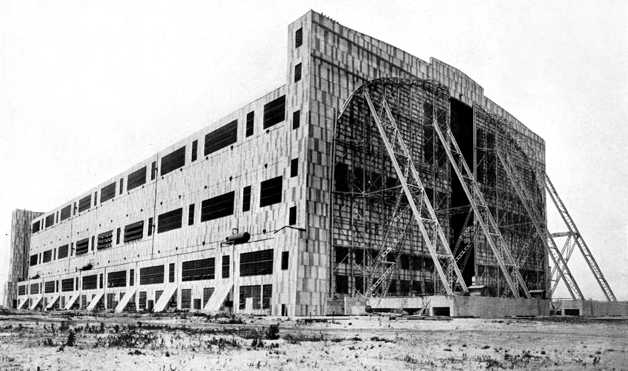
A circa 1920-21 photo of Lakehurst Hangar #1 while under construction (from the Irwin & Leighton archives, courtesy of Cindy Hodgson).
The Lakehurst base had a curious start in 1915 as an ammunition proving ground for the Russian Imperial Government & then the US Army Chemical Warfare Service.
It served in this capacity until 1921,
at which point it was commissioned by the US Navy as a Naval Air Station.
The Navy's aerial facilities at Lakehurst would eventually come to comprise 3 distinct airfields,
with a total of 6 large hangars.
The original Lakehurst airfield is located on the eastern side of the base.
The 1st hangar at the Lakehurst east airfield was known as Hangar 1.
It was based on the typical designs of World War I airship hangars.
It resembled many of the rigid airship hangars built in Great Britain
which used counter-balanced doors in lieu of the steel supporting framework generally found in German hangar design.
The construction contract for Hangar 1 was awarded to the Lord Construction Company on September 8, 1919.
The first of 10 trusses were erected by the Bethlehem Steel Company on May 8, 1920.
The hangar consisted of 3 pinned, arched steel trusses supported on steel towers.
The outer columns & chords supported the side wall framing & siding.
Shops, offices and service areas with mezzanines were located on each side along the entire length of the hangar.
The steel structure was lightweight rolled sections joined by riveted gusset plates.
Hangar 1's trusswork supported catwalks on several levels along each side,
across the end arches and along the centerline of the ceiling.
Siding & roofing were corrugated cement & asbestos panels
in 2 different shades of brown & one shade of gray for camouflage purposes, which proved a checkerboard effect.
Construction was completed on Hangar 1 in 1921, at a cost of $4 million.
It had exterior dimensions of 966' long, 350' wide, and 224' high,
and had a total of 211,434 square feet of interior area.
The earliest depiction which has been located of the Lakehurst airfield
was a circa 1920-21 photo of Lakehurst Hangar #1 while under construction (from the Irwin & Leighton archives, courtesy of Cindy Hodgson).
According to Cindy Hodgson, Irwin & Leighton was the firm that built the original Lakehurst hangar.
The 2-leaf sliding, counterbalanced doors at each end of the hangar were massive;
each door leaf weighed 1,350 tons & measured 136' wide, 177' high, and 76' deep at the base.
The hangar was designed to be as safe as possible, considering the use of hydrogen.
The floor was spark-proof, and electrical panels & lighting were explosion-proof.
Adjacent to the hangar were facilities for helium purification.
A helium storage tank, or gasometer, was located north of Hangar 1.
Helium was piped directly into the hangar in sealed piping.
Although hydrogen was not used for the Navy rigid airships,
it was made available to the German Zeppelins from railroad tank cars.
Hangar 1 originally included a system of trolley tracks serving as docking rails for airship handling.
These rails ran through the hangar & 1,500 feet from each end onto the landing areas.
With developments in rigid airship handling, the track system was revised
and the tracks through the hangar ran to a hauling-up or docking / undocking circle to the front (west) of the hangar.
A system of tracks led to 2 mooring-out circles for trolley masts,
the stern beams and riding-out cars for mechanical handling of rigid airships.

A 9/4/1923 photo of the rigid airship USS Shenandoah (ZR-1),
pictured leaving Lakehurst Hangar #1 (probably for the very 1st time).

A 10/15/1924 photo (courtesy of Gary Fitton) of the airship USS Los Angeles ZR-3 at NAS Lakehurst.
According to Gary Fitton, the photo is “what I believe to be the delivery flight of the ZR-3 to NAS Lakehurst.
Found in my Grandfather’s house in Lakewood NJ in the late 1940s.”
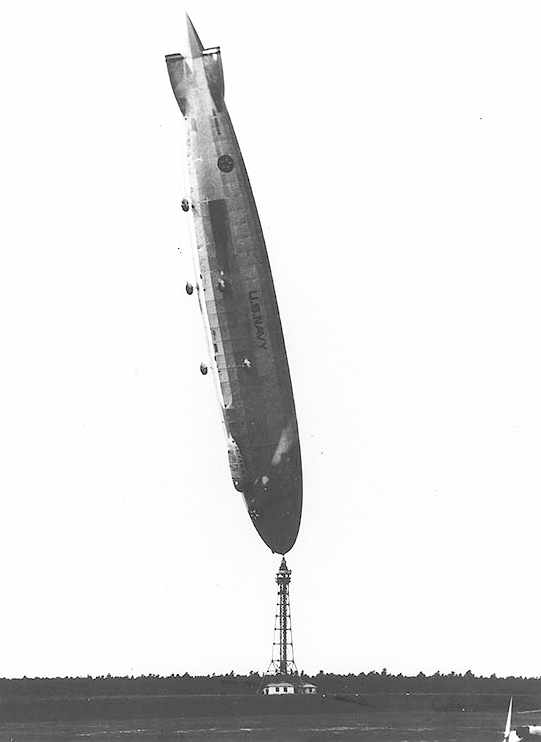
An amazing 8/25/27 photo of the USS Los Angeles ZR-3
after her tail rose out-of-control to 85 degrees while she was moored at the Lakehurst high mast.
This incident resulted from the sudden arrival of a cold air front that lifted the airship's tail,
causing it to rise before she could swing around the mast parallel to the new wind direction.
The USS Los Angeles suffered only minor damage, but the affair demonstrated the risks involved with high mooring masts.

A November 1928 photo looking west at the mooring mast in front of Lakehurst Hangar #1.
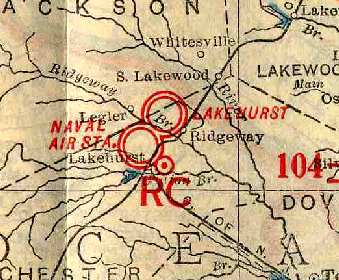
The earliest map depiction which has been located of the Lakehurst airfield
was on the 1930 "Rand McNally Standard Map of NJ With AirTrails" (courtesy of Chris Kennedy).
Lakehurst was the consummate rigid airship station.
Hangar 1 often housed 2 rigid airships & 3 or 4 of the smaller non-rigid airships.
When 2 rigid airships occupied the hangar, it became overcrowded,
particularly with the relatively low & wide, but long (186') stern beam for securing the lower fin.
In 1931, due to this overcrowding, Lakehurst's non-rigid airships were transferred temporarily to Cape May, NJ.

Lakehurst NAS, as depicted on the May 1932 J-18 Washington D. C. Airway Map (courtesy of Chris Kennedy).
At one time or another, Hangar 1 housed every active American rigid airship (Shenandoah, Los Angeles, Akron and Macon),
the Graf Zeppelin & Hindenburg, several Army airships (including the semi-rigid airship, RS-1 in July 1927)
and every type of non-rigid airship constructed for the Navy from 1922-60.
Hangar 1 housed the Navy's last rigid airship (USS Los Angeles), which made its last flight 6/26/32.
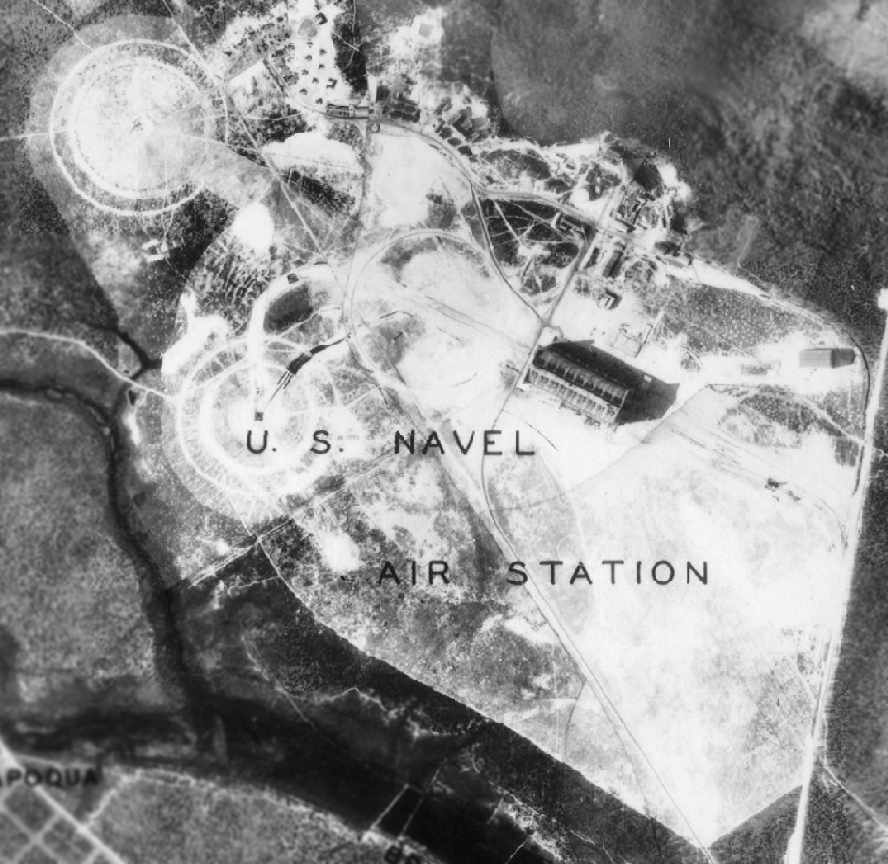
A circa early-1930s aerial view of the Lakehurst “U.S. Navel [sic] Air Station”
depicted the field as having 3 blimp mooring circles, with Hangar 1 in the center of the photo.
What was eventually known as Hangar 4 was visible on the east side.
There did not yet appear to be any runways at the facility.
The 1934 Department of Commerce Airport Directory (according to Chris Kennedy)
described Lakehurst NAS as having three 1,200' sand runways arranged in a triangle.

A remarkable 5/9/36 USCG aerial view (courtesy of Ron Plante) looking west at the Zeppelin LZ 129 Hindenburg's arrival at Lakehurst after its inaugural flight from Friedrichshafen, Germany,
being escorted by a Coast Guard Douglas RD-4 Spica (s/n V-125).
The decommissioned U.S. Navy airship USS Los Angeles (ZR-3) is visible in the background.

A 5/9/36 aerial view (courtesy of Ron Plante) of the Hindenburg being maneuvered into the Lakehurst hangar, its nose hooked to the mobile mooring tower.
The rigid airship had just set a record for its first north Atlantic crossing, the first leg of 10 scheduled round trips between Germany & America.

The only time the Hindenburg was housed inside Lakehurst's Hangar 1 in 1936 (National Archives photo).
The Hindenburg just fit within the hangar, with 18 inch clearance on the bow & stern.

A remarkable 8/9/36 photo of the Hindenburg inside a Lakehurst hangar, dwarfing the Navy ZMC-2 blimp also inside.

A circa 1936-37 photo of the Hindenburg in front of Lakehurst Hangar 1.
The Airport Directory Company's 1937 Airports Directory (courtesy of Bob Rambo)
described NAS Lakehurst as having 3 runways, including a 1,200' east/west concrete runway,
a mooring mast to the northwest, and a hangar to the east.

Lakehurst became infamous on 5/6/37 as the site of the Hindenburg dirigible disaster.
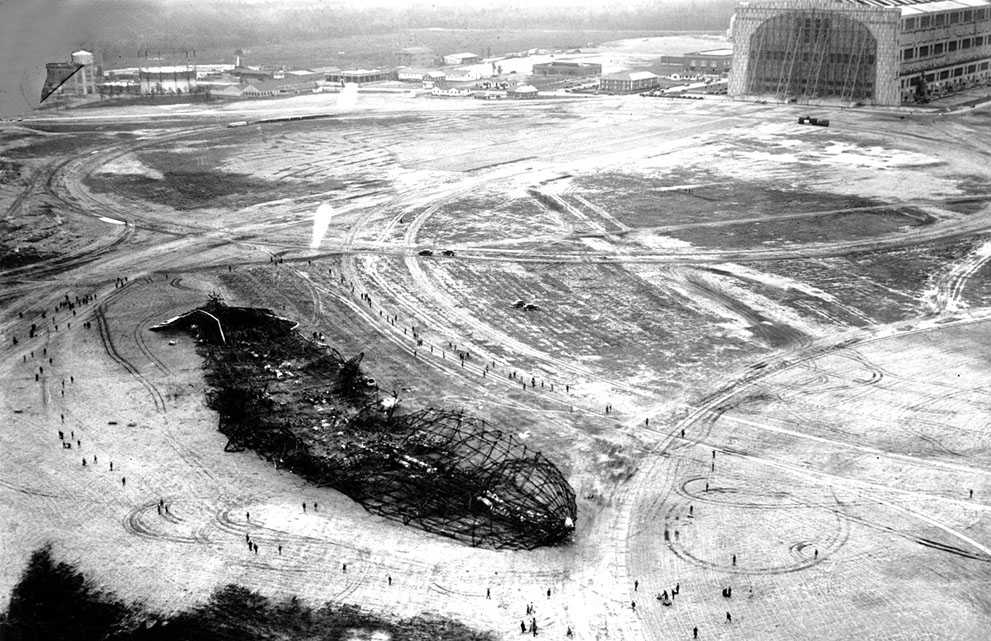
A 5/7/37 aerial view (courtesy of Ron Plante) of the wreckage of the Hindenburg airship in front of the Lakehurst hangar.

A 10/25/37 aerial view of NAS Lakehurst's Hangar 1 & adjacent runways (from the Philadelphia National Archives, courtesy of Ron Plante).
Hangar 1 was the subject of mooring tests as late as 1937.
To house larger rigid airships, it was once proposed that the sliding doors be replaced
with the orange-peel or clam-shell type doors of the Goodyear-Zeppelin design.
This change would have provided additional length at each end of the hangar.
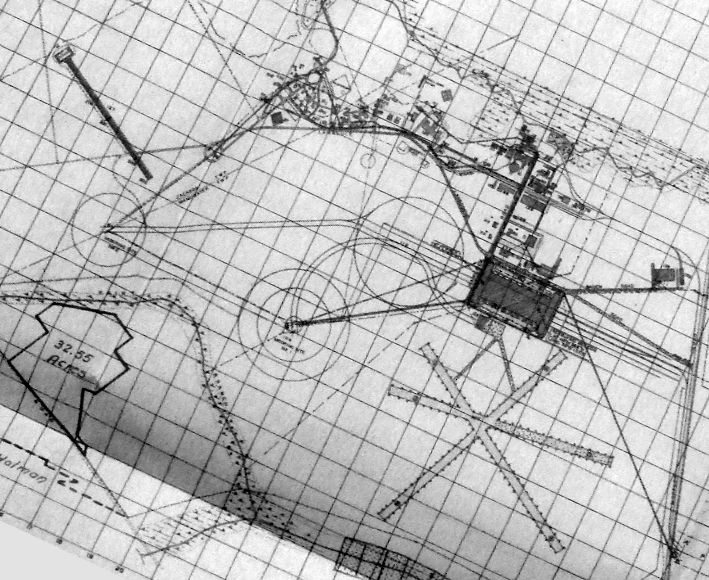
A 6/30/38 map of NAS Lakehurst (from the College Park National Archives, courtesy of Ron Plante)
depicted the 3 runways of Lakehurst East Field, as well as the first runway of West Field (Maxwell Field).
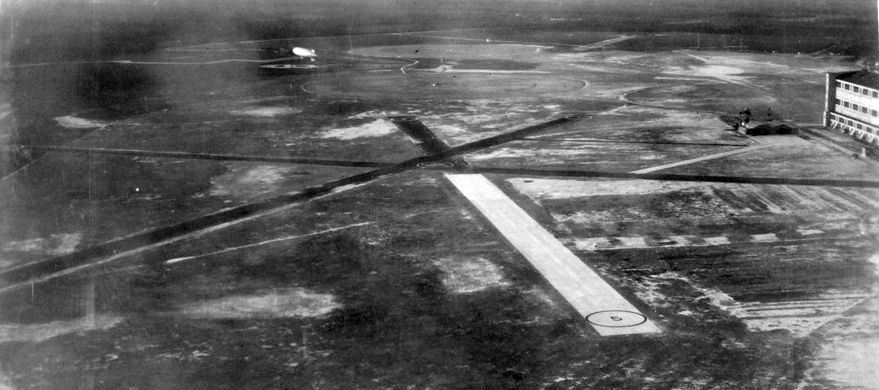
A 12/18/39 aerial view of a blimp over NAS Lakehurst, with Hangar 1 visible at right (from the Philadelphia National Archives, courtesy of Ron Plante).

A late-1930s or early-1940s aerial view looking east at NAS Lakehurst (National Archives photo).
Hangar 4 was visible in the top-left, with Hangar 1 below it.
A set of 3 paved runways had been added just south of Hangar 1.
USS Los Angeles was completely dismantled & removed from Hangar 1 by January 1940.
After 1940, the hangar was used exclusively for non-rigid airships.
Hangar 1 provided sufficient space for all of the Navy's non-rigid airships after January 1940 until 1942.

Ron Plante found this 7/2/40 photo of Lakehurst's Hangar 1 at the National Archives in Philadelphia.
Ron reported in 2016, "This is the same view you'll get today after entering the NAS thru the main gate.
The 1,350 ton back (east) doors you see have not been used in many years the museum people tell me the front doors are opened once a week.
The brick building in the right foreground is still there, and the museum entrance is just past that structure."
Due to changes over the years, only Hangar 1's west doors have been used since the time of the USS Los Angeles,
except during World War II field construction in 1942.

A 6/21/46 aerial view by Don Reid looking west at Lakehurst's Hangar 1, taken from the nose of the K-24 Navy Blimp (courtesy of Bruce Reid).
Bruce Reid observed, “Note the handling lines hanging down from the nose”, coming down from the top of the photo.

The 1948 USGS topo map depicted Lakehurst as having 3 paved runways, with 3 hangars to the northeast,
along with 2 circular blimp mooring fields.

The 1948 USGS topo map depicted Lakehurst's Hangars 1-6.
It depicted the east field as having 3 paved runways, with the longest being 3,800'.
A huge circular “Landing Field” was also depicted to the northwest.
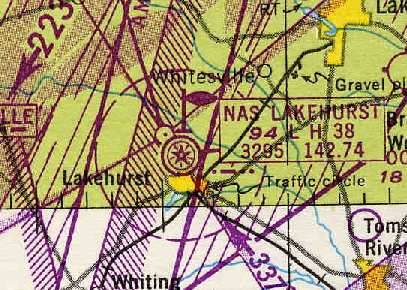
The only airfield at Lakehurst which was depicted on the 1949 NY Sectional Chart (courtesy of Chris Kennedy)
was the original airfield, on the eastern side of the base.
NAS Lakehurst was described as having a 3,800' hard-surface runway.
All 3 runways of NAS Lakehurst-East had prominent closed-runway “X” markings on each end on a 1956 aerial view.
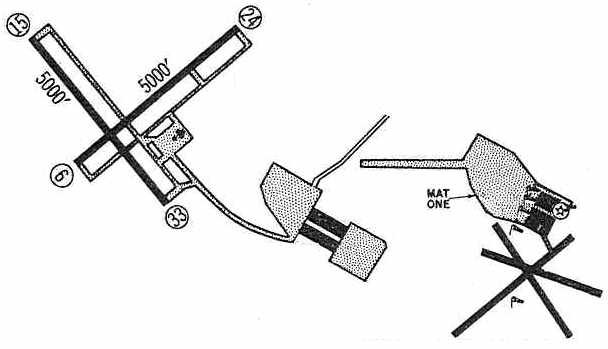
The 1960 Jeppesen Airway Manual (courtesy of Chris Kennedy)
depicted the Lakehurst NAS West Field as having two 5,000' paved runways (6/24 & 15/33).
The 3 runways of the East Field were still depicted,
but it was noted as being "Closed to fixed wing aircraft."

The January 1961 NY World Aeronautical Chart (courtesy of Scott Kimball) depicted all 3 Lakehurst airfields.
Hangar 1 was designated a Registered National Historic Landmark in 1968.
All 3 runways of NAS Lakehurst-East had prominent closed-runway “X” markings on each end on a 1963 aerial view.
What appeared to be a large circular blimp mooring pad was constructed
adjacent to the west side of Lakehurst-East's northeast/southwest runway at some point between 1956-63.
However, NAS Lakehurst-East was still depicted as an active airfield
on the 1969 Washington Sectional Chart (courtesy of Chris Kennedy).

A 1969 photo by George Baczkowski of a Blue Angels F11F-1 Tiger mounted on a pylon by a side gate, with blimp hangars visible in the background.
Michael Capp recalled, “NAS Lakehurst... I was stationed there in the 1960s & 1970s.
The mooring field described above the test facility was used for many years as the Navy Parachute Rigger’s parachute drop zone
(I personally have about 78 jumps into that circle both solo & as an instructor with students).
The circle was also used to test explosive blade bolts for Cobra helicopter ejection/escape systems. And more.
The Naval Air Technical Training Center (NATTC) had schools located at Lakehurst through the 1960s-1980s.
Schools included the Aviations Bosons Mate schools, Navy Weather School, Parachute Rigger School,
and the Marine Corps SATS (Short Air Tactical Strips) school.
The aircraft carrier built inside Hangar 1 was built to accommodate the AB school.
Lakehurst had the only Helium plant on the east coast. It is still located just down the hill from Hangar 1.
The building we taught PR school in was originally built to fabricate & repair airships (both dirigible & balloon),
and had markings in the floor (like a basketball court) that were the templates for airship fabric sections.”

On the 1970 Washington Sectional Chart (courtesy of John Clifford),
NAS Lakehurst East had been downgraded to a heliport.

A May 1971 photo of N15696, a 1936 Bucker Bu-133B Jungmeister, serial #42 at Lakehurst.

A 7/4/76 photo of BuNo 146698, a beautiful North American RA-5C Vigilante, serial #NA296-47, at Lakehurst.
At some point between 1970-91, the Lakehurst East airfield was closed as an aviation facility altogether,
as it was no longer depicted at all on the 1991 Washington Sectional Chart (courtesy of Mike Keefe).
According to Captain Ray Lewis (who went to school in Lakehurst at Hangar 1 in early 1973),
Hangar 1 is "a very unique building & deceptively large.
In fact there is a 1/4 scale carrier flight deck in the Northeast corner of the hangar
that has a working T-29 that we use to direct around for practice on a flight deck.
You have to look hard not to overlook the flight deck - it's that big inside the hangar.
Very cold in the winter & very hot in the summer."
One of the most unusual aircraft ever to fly from Lakehurst was the Piasecki PA-97 Heli-stat.
The Heli-stat had been built under a 1980 U.S. Navy contract for the Forest Service
to demonstrate economic & ecological potential of heavy vertical air lifters
in harvesting timber & other natural resources in difficult-to-get-to terrain.
The demonstration vehicle utilized a Navy ZPG-2W aerostat (with a 1-million cubic-foot envelope)
and 4 surplus Sikorsky H-34J helicopters.
Inflating the aerostat envelope with helium to its length of 343 feet
made the Heli-Stat the largest aircraft in the world (longer than the span of the Hughes flying boat).
The first free hovering flight of the Piasecki PA-97 Heli-stat was made at Lakehurst on April 26, 1986.

A 1986 photo of the Piasecki PA-97 Heli-Stat hybrid vertical heavy lifter hovering over Lakehurst.
On 7/1/86 the Helistat had just completed a test flight successfully & landed at Lakehurst.
A power loss was noted on the #3 helicopter & the test was terminated & the mooring mast called for.
Prior to re-mooring a wind shift caused an uncommanded left turn which the pilot could not counteract with the flight controls.
With a tailwind, no wheel brakes or ground steering a takeoff was attempted.
The 4 main landing gear which had no shimmy dampers started to shimmy.
The 4 helicopters started to react to the shimmy with ground resonance.
As the Helistat finally lifted off, the 4 individual helicopters broke off & fell to the ground.
One pilot was killed, 3 received serious injuries, one received minor injuries, and the Helistat was destroyed.
The power loss on the #3 helicopter was traced to a missing throttle linkage correlation pin.

An undated (circa 1990s?) aerial view looking northwest at the Lakehurst complex,
with Maxfield Field at the left, Hangars 5 & 6 in the center, and Hangars 1-3 at the right.

An undated (circa 1990s?) aerial view looking northwest at Lakehurst,
with Hangars 1-3 in the center, and Hangars 5 & 6 at the upper left.
Bruce Reid recalled, “I spent my entire 37 year Civil Service career at NAS Lakehurst.
That 7,400 acre site had morphed into many entities from 1921.
I started work there at Naval Air Test Facility in 1959, and worked at the 5 track sites, RALS site, Catapults, West Field (Max Field),
Hangars 1, 5 & 6 as well as both Engineering buildings for Integrated Logistics Support for Naval & Marine Corps Aircraft Systems. I retired 1995.”

In a circa 2001 aerial photo, the Lakehurst East airfield still existed relatively unchanged.
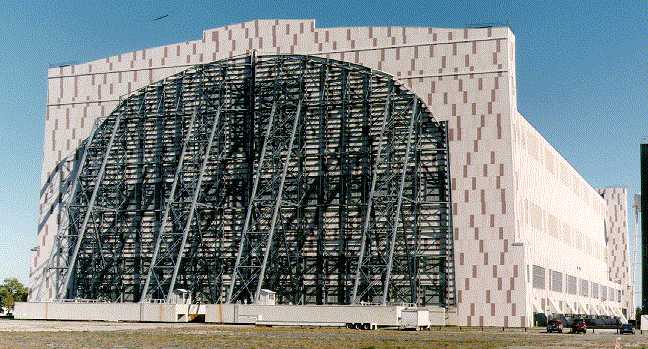
A circa 1990s photo of historic blimp Hangar 1.

In the 1997 USGS aerial photo of the original Lakehurst East airfield,
all 3 paved runways were marked with closed "X" symbols.
The longest of the runways was 4,200'.
As of the late 1990s, the CALASSES (Carrier Aircraft Launch & Support Systems Equipment Simulator)
was located in Hangar 1.
It is a 1/4th scale model carrier deck used for training Navy aircraft operators.

A circa 2006 aerial view looking east at Hangars 1, 2, and 3.

A circa 2006 aerial view looking east at a static display located just north of Hangar 1
of an A-7 Corsair, A-4 Skyhawk, and F-4 Phantom.

A March 2014 photo by Ron Plante of the memorial commemorating the site of the Hindenburg disaster.

A March 2014 photo by Ron Plante looking east at Lakehurst's Hangars 1-3.

A March 2014 closeup by Ron Plante looking northeast at the west side of Lakehurst's Hangars 1 & 2.
Ron Plante reported in 2014, “I saw 2 Short Skyvans that did not appear flyable, plus there was a UH-60 in Army green parked in front of the Maxfield tower.”

A 5/5/15 photo by Tekang Wang of Lakehurst's “Hangars 1, 2 and 3 from the memorial at the center of the field.”
Note the A-7 Corsair, A-4 Skyhawk, and one other aircraft to the left of the hangars.
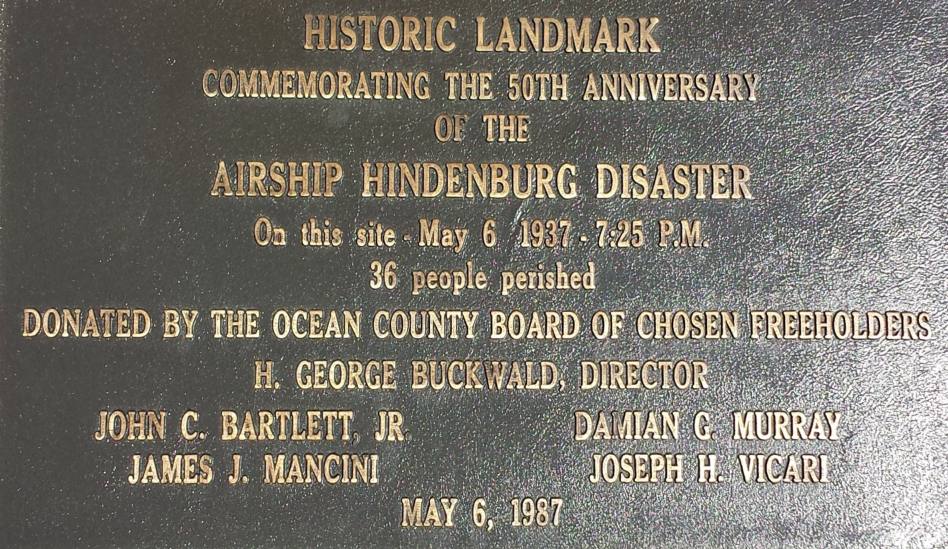
A 5/5/15 photo by Tekang Wang of of the historical plaque at the site of the Lakehurst Hindenburg disaster.

A 5/5/15 photo by Tekang Wang at Lakehurst “of some preparations for the anniversary ceremony which was to occur the next day at the site of the Hindenburg disaster.”

A 5/5/15 photo by Tekang Wang at Lakehurst “of the massive doors at Hangar 1.
The door operating mechanics appeared complete & in fair condition although rusty, as were rails that the doors ride on.”
...........................................................................................................................................................
Lakehurst's Hangar 4 was a World War I hangar relocated from Norfolk, VA.
The hangar was dismantled at Norfolk in 1931 & erection at Lakehurst was completed in early 1932,
northeast of Hangar 1 near the station's east boundary road.
Hangar 4's construction was steel with exterior doors at the west end only.
It had an exterior length of 253' long by 152' wide by 97' high,
and had an interior measuring 33,500 square feet.
Railroad tracks ran from Hangar 1 to Hangar 4.
Hangar 4 was known as the non-rigid hangar
because it was erected for non-rigid airships to alleviate crowding when 2 rigid airship occupied Hangar 1.
After completion, Hangar 4 was used at various times by the airships J-3, J-4, K-1, ZMC-2, G-1, L-1, TC-13 and TC-14.
The hangar was frequently used when 2 rigid airships with railroad masts & stern beams were housed in Hangar 1.
Due to the limited height of Hangar 4, only the smaller, older non-rigid airships could use Hangar 4.
The K-2 airship, the first modern patrol airship constructed in 1938, could only use Hangar 4 if the top fin were removed.
Hangar 4 was used by airships until January 1940.
During World War II, Hangar 4 was occasionally used by airships,
but was used primarily for the free balloons used in training.
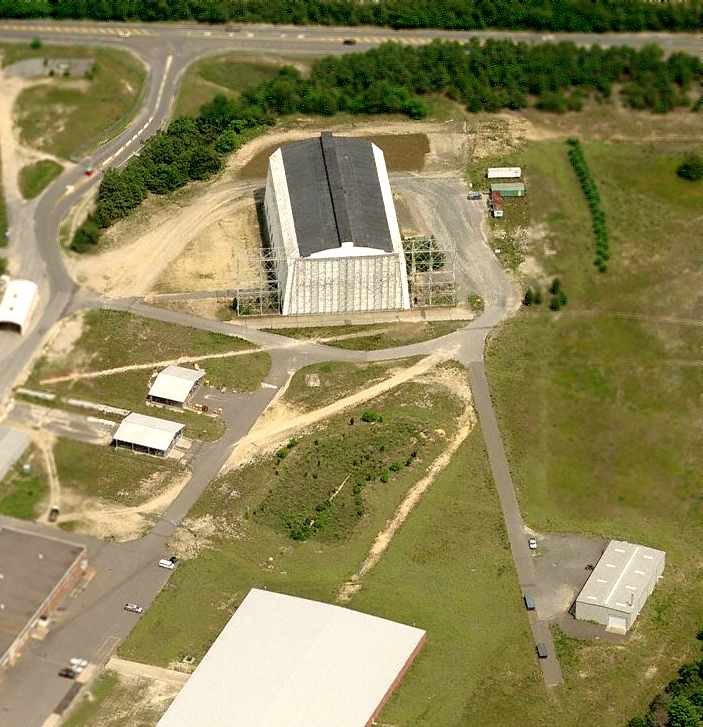
A circa 2006 aerial view looking east at Hangar 4.
Since WW2 the main use of Hangar 4 has been for storage, recently for surplus property.
Joe Panzarino reported in 2009, “Hangar #4 at Lakehurst is the last remaining WW 1 blimp hangar still in existence today.”
...................................................................................................................................
As part of the pre-WW2 6-airship construction program,
Lakehurst's Hangars 2 & 3 (with bypassing sliding doors) were begun.
Hangars 2 & 3 were erected by the Duffy Construction Company of New York City
and were built adjacent to the southwest side of Hangar 1.
Hangar 2 was the 1st airship hangar to be erected for the Navy since the Moffett Field hangar in 1933
and was intended as an overhaul & fitting-out facility.
Construction was started on June 24, 1941 and was completed on May 13, 1942.
Hangar 2 had exterior dimensions of 614' long, 217' wide, and 118' high,
and had 93,620 square feet of interior space.
Hangar 3 was designated for the use of training airships
and was started on August 1, 1941 and completed on June 30, 1942.
Hangar 3 had exterior dimensions of 414' long, 217' wide, and 118' high,
and had 62,650 square feet of interior space.
Hangars 2 & 3 were used in the post-WW2 period to house ASW helicopter squadrons.
.......................................................................................................................................................................................
Lakehurst's Hangars 5 & 6 were authorized on July 3, 1942,
to be located in the center of the Lakehurst base.
They were built to an identical WW2 design, made of wood due to the wartime scarcity of steel.
Hangars 5 & 6 were erected by joint general contractors Karno-Smith Company of Trenton, NJ
and Duffy Construction Company of New York City,
with the Phoenix Bridge Company brought in to erect the arches.
The track-mounted triangular travelers used to erect the arches had been used previously
in the construction of the George Washington Bridge over the Hudson River at New York City.
Truss members were precut on the west coast by Timber Structures, Inc.,
shipped in specially heated railroad cars & fire-proofed in transit.
There were only a few problems during the hangars' construction;
namely finding sufficient labor because industries in the New York City & Philadelphia areas had absorbed manpower.
This necessitated recruiting labor in other areas.
The airship training that was in progress at Lakehurst during the time also complicated the construction work.
Construction on Hangar 5 was completed on July 1, 1943,
and Hangar 6 was completed on August 15, 1943.
Once completed, Hangars 5 & 6 were the largest single-arch structures in the world.
They had exterior dimensions of 1,086' long, 297' wide, and 183' high,
and had a total of 241,110 square feet of interior area.

An undated (circa 1990s?) aerial view looking southeast at Hangars 5 & 6.
According to Army Aviator Tom Kahlert, “The Hueys & Beech twins were active Army Flight Detachment assets which supported VIP & laboratory requirements at Ft Monmouth before all were disbanded.”

A circa 2006 aerial view looking east at Hangars 5 & 6.

A circa 2006 aerial view looking east at what appeared to be the only active aircraft on the entire Lakehurst airfield complex:
two Shorts C-23 Sherpa light transports, parked on the ramp just northwest of Hangars 5 & 6.
......................................................................................................................................................
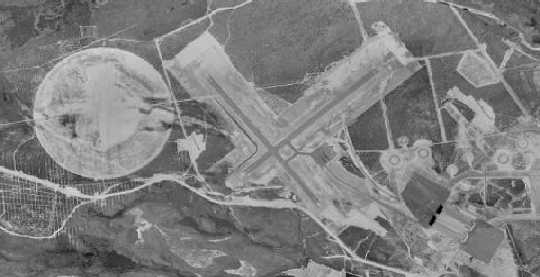
A 1956 aerial view depicted Maxfield Field as having 2 paved runways.
Maxfield Field (in the center of the base) was built at some point between 1951-56.
The earliest depiction of the field which has been located was a 1956 aerial view .

A closeup from the 1956 aerial view depicted the ramp on the east side of Maxfield Field as having 2 R4D transports
and a large number of single-engine aircraft, some being carrier-based planes with folded wings.
The earliest aeronautical chart depiction of Maxfield Field which has been located
was on the 1957 NY Sectional Chart (courtesy of Mike Keefe).
It depicted NAS Lakehurst West as having a 5,000' hard-surface runway.

The 1958 NY Sectional Chart (courtesy of Chris Kennedy)
depicted NAS Lakehurst West & NAS Lakehurst East.
A 1963 aerial view showed that a hangar had been built just east of Maxfield Field's runway intersection at some point between 1956-63.

The 1997 USGS aerial photo of Maxfield Field,
hangars, and several circular blimp mooring circles.

A circa 2001 aerial photo of Maxfield Field.
As of 2003, Maxfield Field was still operated as an active air facility, with two 5,000' runways.
Douglas Wright reported in 2004 that Lakehurst is receiving a new or upgraded 6,500' runway
to support assault landing training by the C-17s which are being assigned to nearby McGuire AFB.
It is not known where on the Lakehurst complex this runway will be located -
whether it will be an entirely new runway or an upgrade of one of Maxfield Field's existing runways.

A circa 2006 aerial view looking north at the post-WW2 fixed-wing aircraft hangar & control tower on the east side of Maxfield Field.
Douglas Wright reported in 2010 that Lakehurst's new assault strip “is now a reality.”
It is a 3,500' paved runway parallel to Runway 6/24 on the northwest side..
......................................................................................................................................................
The Naval Air Test Facility (on the west side of the Lakehurst base) consists of 2 very large facilities:
a set of 5 tests tracks on the north side, and the NATF runway to the south.
A 1956 aerial view showed the beginnings of the NATF facilities, with the 1st test track (the northern one) having been built.
A 1963 aerial view showed that all 5 test tracks had been completed at some point between 1956-63.

The 1997 USGS aerial photo of the NATF runway, catapult sled test tracks,
and the circular blimp mooring field to the northeast.

As described on Lakehurst's web site in 2003, the 5 test tracks are up to 9,150' long.
A sled propelled by 4 J-48 jet engines (developing a total of 42,000 lbs of thrust)
is used to propel weighted deadloads (up to 100,000 lbs) or airframes
down the track (at speed up to 250 knots) into the arresting gear or barricade under test.
The remote location provides a safety & noise buffer.
Runaway deadloads have harmlessly wandered off into the woods.
The site has been used by the Air Forces, FAA and foreign governments.
The primary Navy use is wire rope acceptance tests, barricade testing,
and arresting gear evaluation & verification.

An undated (circa 1980s/90s?) photo of the Lakehurst test track, with an F/A-18 airframe mounted on the jet-propelled sled.
......................................................................................................................................................
The NATF runway was built to conduct aircraft carrier catapult & arresting gear tests,
with a catapult & arresting gear built into the runway.
A 1956 aerial view showed the beginnings of the NATF facilities,
with the only the western end of the NATF runway having been constructed.
A 1963 aerial view showed that the entire length of the NATF runway had been completed at some point between 1956-63.
The earliest aeronautical chart depiction of the NATF runway which has been located
was on the 1960 Washington Sectional Chart (courtesy of Mike Keefe).
It depicted NATF Lakehurst as having a single 7,600' paved runway.

The 1962 Washington Sectional Chart (courtesy of Chris Kennedy)
depicted NATF Lakehurst as a single 7,600' runway, NAS Lakehurst West as 2 runways (longest 5,000'),
and NAS Lakehurst East as 3 runways (longest 3,800').
Within the next 2 years, the NATF runway was extended to its ultimate length of 11,600',
as that is how it was depicted on the 1964 Washington Sectional Chart (courtesy of Chris Kennedy).

An undated (circa 1980s/90s?) photo of the Lakehurst NATF runway.
The NATF runway was still depicted as an active airfield
on the 2000 Washington Sectional Chart (courtesy of Chris Kennedy).
The Naval Air Test Facility was evidently closed at some point between 2000-2001,
as it was no longer depicted at all on the 2001 Washington Sectional Chart (courtesy of Chris Kennedy).
Given that the runway is over 11,000 feet long,
it would have seemed reasonable to still depict it on the chart as an abandoned airfield,
both for landmark value & for possible emergency use.
However, although it is no longer listed as an active airfield,
the NATF runway was still described on Lakehurst's web site in 2003.
The 3 components of the NATF runway complex are the Catapult Test Site,
the Runway Arrested Landing Site, and the Jet Blast Deflector Site.

An undated (circa 1980s/90s?) photo of an F/A-18 on the Lakehurst catapult.
The Catapult Test Site has 2 catapults: the TC13 Mod 0 & TC13 Mod 2.
Both catapults can launch aircraft or deadloads up to 100,000 lbs with speeds up to 185 kts.
This is the only facility in the world with deadload launch capability.
The TC13 Mod 2, developed at Lakehurst, will save the Navy up to $1/2 billion per ship over the life cycle.
The lower pressure demands from the ship's reactor lengthens the time necessary between reactor recoring.
The site steam plant can produce up to 138,000 lbs per hour.
The site has been used to conduct tests for the Army, Air Force, NASA,
and private industry (McDonnell-Douglas, U.S. Rubber).

The Runway Arrested Landing Site is the only site in the world that allows
high-speed roll-in & fly-in arrestments on shipboard & landbase arresting gear.
It provides over 3,000' prior to arrestment & an 8,000' safety buffer after arrestment.

The Jet Blast Deflector Site is the only site in the world that can conduct aircraft acceptance tests
that demonstrate compatibility with the JBD.
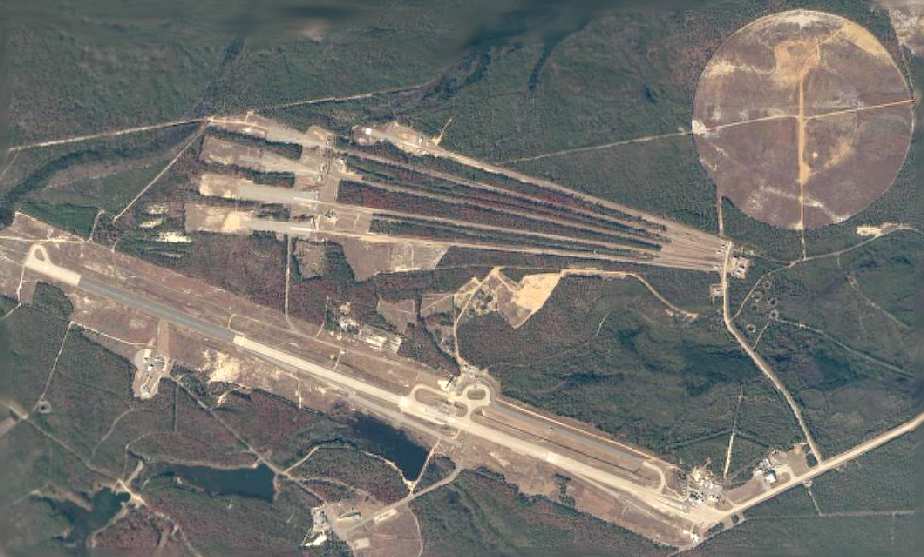
A circa 2001 aerial photo of the NATF runway.
Also note the catapult sled test tracks north of the runway,
and the circular blimp mooring field to the northeast.

A 2005 aerial photo by Tom Kramer, looking east.
The photo captures in one view a remarkable array of historical airfield infrastructure,
including the NATF runway in the right-foreground,
the 4 catapult test tracks behind it to the left, the blimp mooring circle, the 2 perpendicular runways of Maxfield Field,
and the giant pair of blimp Hangars 5 & 6 in the background.
Douglas Wright reported in 2010, “The NAEC has added a magnetic catapult which they are testing.”

A 6/25/11 aerial view of a new Lockheed F-35C Lightning II arriving at Lakehurst for carrier testing, with the Lakehurst NATF runway visible in the background.

A 10/15/11 USAF aerial view looking east by Ryan Throneberry of a Marine AH-1W Super Cobra helicopter of Light Attack Helicopter Squadron 773,
with almost all of the historic Lakehurst aviation infrastructure visible in one photo.
The Super Cobra was providing support during a Joint Tactical Recovery of Aircraft and Personnel exercise,
which tested the Reservists’ ability to recover downed aircrews behind enemy lines.
____________________________________________________
Preston Airport / Marlboro Airport (2N8), Marlboro, NJ
40.366, -74.253 (Southwest of New York, NY)

A 1957 aerial view depicted Preston Airport as having 2 grass runways.
A row of 7 T-hangars was located on the northeast side of the field,
near which were parked at least 2 light aircraft.
This is yet another one of a staggering number of former general aviation airports
which have closed in the last few decades in NJ.
Marlboro was in operation as an airport for nearly 50 years.
It was originally known as Preston Airfield.
Flight enthusiast Rhea Preston was granted permits in 1954 to operate an airport on his farm.
A grass runway was laid out along a flat portion of Preston's farm,
according to the book "Images of America: Marlboro Township".
Candee Preston recalled, “Preston Airport... It was my dad, Rhea Preston, who began the whole operation in 1954.
When they closed [Hazlet Airport] to put up the shopping center, is when my dad opened Preston.
I have the original state license given to my dad for the airport.
It is an interesting story how he achieved that feat.
He went to Marlboro Township officials one day & asked if there were any restrictions on an airport in town.
When they said, no, he drove to Trenton, filed the paperwork, and was issued the license.
Needless to say, some people in town weren't too pleased.
The gas tanks at Preston were installed on my brother's birthday, 5/30/55.
It was a hobby for my dad, but provided him with his love of flying & a little extra income.
My dad taught me to fly, and at 16 I became the first female to solo there, and later I achieved my license at age 18.
I have many fond memories of the airport.
My family had many great times there, and many local people learned to fly.
As a matter of fact, when people from Preston would go to Red Bank to be licensed,
the instructor would always tell them that he knew they learned to fly at Preston, because they could land using a minimal amount of runway.”
The earliest photo that has been located of Preston Airport was a 1957 aerial view.
It depicted Preston Airport as having 2 grass runways.
A row of 7 T-hangars was located on the northeast side of the field,
near which were parked at least 2 light aircraft.
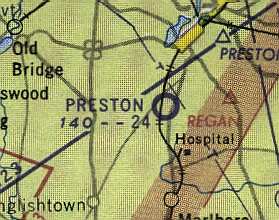
The earliest aeronautical chart depiction which has been located of Preston Airport
was on the 1957 NY Sectional Chart (courtesy of Mike Keefe).
It depicted the field as having a 2,400' unpaved runway.
Preston Airport was described on the 1958 NY Sectional Chart (courtesy of Norman Freed)
as having 2 turf runways, with the longest being 2,400'.
A 1963 aerial view depicted Preston Airport as having 2 grass runways.
A building had been added along the southeast side of the field at some point between 1957-63,
and the total number of aircraft visible on the field had increased to over 20.
The 1965 NY Sectional Chart (courtesy of John Voss)
described Preston Airport as having 2 turf runways, with the longest being 2,400'.
Chuck Maire recalled, “I worked at Marlboro for the Fenwicks as a flight instructor.
It was the most country club type atmosphere I knew in my career.”
Preston Airport was still described on the 1967 NY Local Aeronautical Chart (courtesy of Mike Keefe)
as having 2 turf runways, but the longest runway had been shortened to 2,170'.
Preston Airport was not depicted at all on the 1970 USGS topo map, inexplicably.
In 1970, Everett & Dorothy Fenwick bought Preston Airport.
A 1970 aerial view showed that a new, longer grass runway had been built somewhat to the north at some point between 1963-70.
The number of aircraft visible on the field had also blossomed to over 50.
Tim Farmer recalled, “Marlboro Airport [Preston] was a special place for me.
I grew up about 5 miles away in Cheesequake.
The sight of the DelRosso's Stearman, which had been based at Marlboro,
over our home in the early 1970s may very well be what sparked my interest in aviation.
Numerous trips to the airport for family breakfasts followed by flights in that Stearman kept it alive
(in those days they would charge $15 for a 20-30 minute flight).
I later learned to fly at Marlboro.”
Preston Airport had gained a paved runway at some point between 1970-72,
as seen on a 1972 aerial photo.
Anton "Tony" Wittkamp recalled, “After Everett Fenwick & his wife Dorothy bought the airport in the early 1970s
a substantial amount of money was spent upgrading it & made it into one of the best general aviation airports in NJ.
We had Christmas parties at a local rented hall & cookouts in a grove of trees at the west end of Runway 27.
I still miss the airport and all the characters that met there regularly on Saturday & Sunday for breakfast
after which they went out to fly or just hung out in the small pilots' lounge.
The airport manager was Ed Kulus (also an FAA examiner) who later went to work for the FAA at Teterboro.
He ran a tight ship which benefited everyone.”

The 1975 NY Local Aeronautical Chart (courtesy of Mike Keefe)
depicted Preston as having a 2,200' paved northeast/southwest strip.
Kevin Smith reported, “I learned to fly at Marlboro Airport in 1976-77.
[It] was charming. I have good memories from there.”
The airport was renamed at some point between 1975-79 as Marlboro Airport,
as that is how it was depicted on the 1979 NY TCA chart (courtesy of Bill Suffa).
It was described as having a single 2,200' paved east/west runway.

The 1981 USGHS topo map depicted Marlboro Airport as having 2 paved runways.
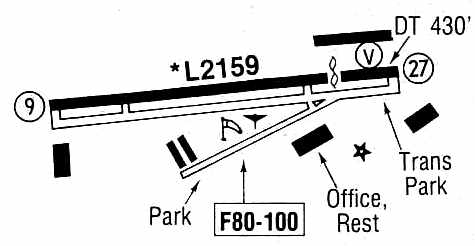
The 1983 Flight Guide (courtesy of Chris Kennedy)
depicted Marlboro as having a single 2,159' paved Runway 9/27,
and a parallel taxiway on the south side.
A total of 6 buildings (hangars?) were depicted on the airfield.

The last aeronautical chart depiction which has been located of Marlboro Airport
was on the June 1985 NY Sectional Chart (courtesy of Mitchell Hymowitz).
It depicted Marlboro as having a 2,200' paved northeast/southwest strip.
Anton "Tony" Wittkamp recalled, “At its high point about 1985/90 there were probably 80-100 aircraft on the field.
This all went downhill after the death of Everett Fenwick at the young age of 58.
Those were indeed the 'good old days'.”
In April of 1986, Marlboro Airport was bought by Leonard & Aletta Genova for $750,000.

A September 1992 aerial view by Daniel Berek looking southeast at Marlboro Airport,
taken from a Stearman biplane, showing the airport quite healthy – with 18 light aircraft visible on the field.
The 1995 Jeppesen Airport Directory depicted Marlboro Airport in basically the same manner as shown in 1983.
In the late 1990s, in ill health, Dr. Genova attempted to find a buyer who would keep the airport open.
In July of 1997, Lino Fasio & his partners signed a contract to buy the airport for $1 million.
But in October of 1997, Fasio's partners & Genova backed-out of the deal, causing Fasio to sue.
A Superior Court judge temporarily barred the Genovas from selling the airport to anyone else.
In late 1997, the story of this embattled little airport took a very unfortunate turn,
as Fasio claimed his 2 airplanes were being sabotaged.
On March 4, 1998, Fasio's plane crashed into a condominium in Hillsborough,
killing Fasio & his passenger, Eric Shibla.
In May of 1999, Marlboro Airport owner Dr. Genova died.
In August of 1999, developer Terry Sherman offered $1.2 million to buy the airport,
but the offer was rejected by Mrs. Genova.
In February of 2000, Marlboro Holdings LLC, a company formed by a pilot & 2 Staten Island men,
bought the airport for $1.1 million.
An attorney representing the new owners said they intended to maintain the property as an airport
and "do everything possible to make it a prime airport facility."
However, in late 2000, Marlboro Holdings & developers Anthony Spalliero & Terry Sherman
entered into a partnership to develop the airport for housing, according to Spalliero.

An October 2000 aerial view (courtesy of Tim Farmer), looking west at while on final approach for Marlboro's Runway 27.
Tim recalled, “It was taken late in the afternoon, on a very hazy day in October of 2000,
upon return from Block Island, by my girlfriend Niveen.
It very well may have been the last approach & landing I ever made at Marlboro.
We moved to San Diego a few weeks later.
Few airports have the charm that Marlboro did.
There was something about being there,
especially on a warm spring morning with the smell of clover & fresh cut grass permeated the air
and the sound of airplanes broke the silence.”

A 12/31/01 aerial view looking northwest depicted a popular Marlboro Airport just before the field's closure, with a large number of aircraft on the field.
In 2001 or 2002, Marlboro Mayor Matthew Scannapieco accepted a $100,000 bribe
to speed higher-density residential zoning on the airport, the mayor later admitted in federal court.

A vintage Soviet Antonov An-2 biplane, based at Marlboro Airport until its closure.

A spring 2002 photo of a Cessna 172 taking off from Marlboro, just months before the field closed.
In 2002, its last year of operation, its published statistics listed a total of 41 resident aircraft,
with an average of 61 takeoffs/landings per day.
Three business were based at the field in 2002: Marlboro Flight Services (the Fixed Base Operator),
Certified Flyers II (which provided flight training & aircraft rentals), and the Monmouth Area Flying Club.
Up until this airport's closure in 2002,
its web site described itself as "The friendliest little airport in NJ!"
In conjunction with the change in ownership,
a businessman who has operated at the airport for more than 3 decades said he was being evicted.
Richard Fenwick, president of Deep Run Repair & Aircraft Maintenance Corp.,
said he operated his business at the airport for 33 years.
Fenwick said he received an eviction notice from Marlboro Holdings shortly after their purchase of the airport.
Fenwick, whose brother, Everett Fenwick, was the former owner of Marlboro Airport,
said he doesn’t know why the new owners are telling him to leave.
He said he does not have a lease for his space,
having had understandings in place with each of the airport’s previous owners:
Ray Preston; then his brother & sister-in-law; and finally with Genova.
However, only 2 years after purchasing the airport,
Marlboro Holdings LLC announced their plans to close the airport in 2002
and redevelop the property for a more financially lucrative purpose - building housing.
But the patrons of the airport, many of whom had been coming for decades,
began a grassroots movement with hopes of preserving the facility.
Known as the Committee to Save Marlboro Airport,
the group circulated a petition against rezoning the property.
Marlboro Holdings LLC requested a change in zoning that would allow for
the construction of an adult community of about 300 homes.
A flier distributed by the Committee to Save Marlboro Airport states,
"It has never been a secret that since the sale of the airport to its present ownership,
there has always been a subversive desire to close the airport & rezone it for another housing project."
State Department of Transportation spokesman John Dourgarian said he had not heard of plans to close the airport.
"Certainly, we’d like to see Marlboro Airport preserved," Dourgarian said.
"We don’t have a lot of (general aviation airports) left ... when you lose one it affects all of the others."
Dourgarian said the airport’s safety record was not considered noteworthy.
Marlboro is one of 50 general aviation airports left in the state, he said.
According to Rasmussen, of the DOT, the Marlboro Airport owners made no requests for financial assistance.
Members of the Committee to Save Marlboro Airport said they know the odds are long.
"We’re not sophisticated in any political way -
we’re just a group of people who know right from wrong," said Jay Thorpe.
"It’s really like David & Goliath, except Goliath has no face.
Goliath didn’t need to show up at Planning Board meetings."
But ultimately their efforts were not successful, and the airport's closure was made final in 2002.
In the letter to municipal officials, Berman seemed to address financial issues relating to the facility,
adding, "Despite our best efforts, we have to face the reality that it is not possible
for us to continue to operate the property as an airport."
However, several airport supporters have said it was mismanagement
on the owners’ part that was responsible for any losses.
"It’s interesting to me that it remained profitable for more than 40 years before they owned it.
You don’t have to be a business major to see that they’ve tried to run the place into the ground," Thorpe said.
Marlboro Councilwoman Mary Singer said, "The airport’s been a real asset for Marlboro,
and I’m disappointed they couldn’t find a different buyer.
It’s different than buying something like a drugstore & keeping it open as a drugstore - it’s a very specialized operation."
Aircraft owners at Marlboro Airport were forced to seek new spaces
among a quickly shrinking group of general aviation airports in New Jersey.
Since WW2, New Jersey has lost about one small airport per year,
according to state Department of Transportation spokesman Micah Rasmussen.
When Marlboro Airport closed in 2002, only 48 small general aviation airports were left statewide.
In Monmouth County, only 2 airports will remain (Monmouth Executive & Old Bridge).
According to airport mechanic Bill Bienes,
"People who have their airplanes in New Jersey are not going to get hangars in New Jersey.
There are none to be had."

Aerial view of Marlboro looking west, shortly after its closure.
© 2002 by Rich Galiano, used by permission.

Aerial view of Marlboro looking east, shortly after its closure.
© 2002 by Rich Galiano, used by permission.

A view over the end of Runway 27 to the northwest at the hangars at Marlboro.
© 2002 by Rich Galiano, used by permission.
At the time of its closure, the airfield at Marlboro consisted of a single 2,156' asphalt Runway 9/27,
asphalt taxiways, a grass tie-down area, several T-hangars, and office, and a popular café.
The property consisted of a total of 53 acres.
Rich Galiano reported in 2003 that "Zoning problems seem to be holding up the redevelopment of Marlboro,
which is virtually unchanged since it closed, except for some vandalism of the now-vacant buildings."
Rich Galiano reported in 2004, "I flew over Marlboro the other day: the runway is still intact.
I guess when the new owners turned out to be sleazy developers,
the town decided to screw them, and the re-zoning never went through.
They wanted to build old-folks housing, what a local graffito referred to as a 'Senior ghetto'."
William Angus reported in 2005, “Marlboro Airport seems to be in the same shape
and position as it was in the most recent reports,
though the buildings may have deteriorated.
I drove by... the place was plastered with no trespassing signs.”
In a sad postscript to the Marlboro Airport story,
in April of 2005, former Mayor Scannapieco plead guilty in federal court
to accepting a total of $245,000 from a developer, later identified as Spalliero.
In May of 2005, Spalliero was charged in federal court for passing bribes to public officials,
including $100,000 to Scannapieco.
Rob Kulat reported in 2005, “Recently I've been reading that many residents
want it to be an airport again instead of more housing.
People are starting to wake up to the fact that life would be worse with more traffic & houses, rather than with a few aircraft.”
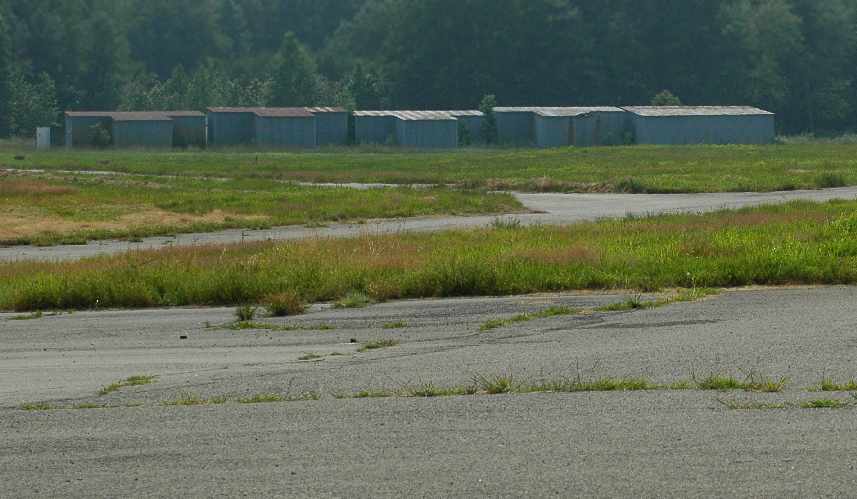
A July 2006 photo of the former Marlboro hangars by Andy Zink.
Andy reported, “There's a bike path that runs right by the end of the runway.
Nothing has really changed recently except a few more pieces of grass breaking through the runway & taxiways.
Some of the hangars are open.”

A July 2006 photo of the former Marlboro runway by Andy Zink.

A July 2006 photo of former hangars on both sides of the runway at Marlboro by Andy Zink.

A circa 2007 photo of the sign at the entrance to Marlboro Airport.
Anton "Tony" Wittkamp recalled, “I I visited Marlboro Airport in June 2010.
I walked the entire airport & its current condition brought tears to my eyes.
The buildings are in a state of decay except the office, pilots lounge & cafe which seem to be holding up OK.
The large metal hangar next to the cafe is still in good shape but other hangars on the north & west side are falling apart.
The runway is still in good shape although weeds are coming up from the cracks & I suspect will now accelerate due to lack of use.”
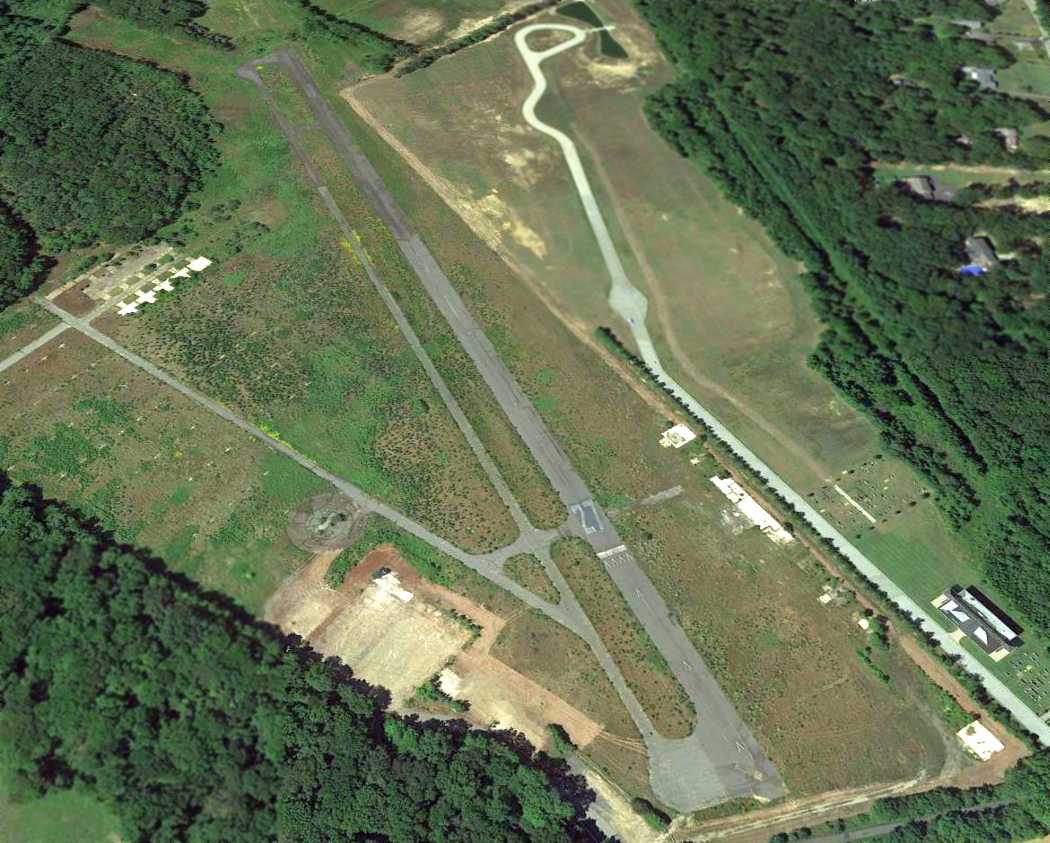
A sad 9/6/13 aerial view looking northwest at the remains of Marlboro Airport.
What a shame that the aviation infrastructure of this nice little general aviation airport continues to be wasted.
Candee Preston (daughter of the Preston Airport founder) recalled,
“I chuckle when I read how the people of Marlboro wanted to save the airport.
Growing up, most of the area residents wanted it closed. How times have changed.”

An 8/16/15 photo by Kevin Smith looking west along the remains of Marlboro's Runway 27 displaced threshold.
Kevin Smith reported, “It is an overgrown ruin now, with no standing buildings. The runway & taxiways are cracked up & full of high weeds.”
Marlboro Airport is located west of Route 79, south of Brown Road.
See also:
____________________________________________________
Schlossbach Field / Asbury Park Neptune Air Terminal (ARX), Asbury Park, NJ
40.22, -74.09 (South of New York, NY)

A postmark commemorated the 7/31/41 Dedication of Schlossbach Field.
Naval aviator Issac Schlossbach purchased a 125-acre parcel of farm land in Neptune, off Route 66, in 1935
and opened an airport in 1938 under the name Ikes Jersey Aero Club -
one of the first airports in central New Jersey.
The earliest depiction which has been located of the field was on a 1940 aeronautical chart,
which labeled it as "Schlossbach".
A postmark commemorated the 7/31/41 Dedication of Schlossbach Field.
Schlossbach Field trained military flying instructors during World War II, according to an article by Don Stine in The Coaster.
The earliest depiction which has been located of Schlossbach Field
was on the 1945 NY Sectional Chart (courtesy of Norman Freed),
which depicted Schloessbach as an auxiliary airfield.
Schlossbach Field was not yet depicted on the 1947 USGS topo map.

A 1947 aerial view depicted Schlossbach Field as having 3 grass runways.
Several buildings were located on the north side of the field,
around which were parked 7 light aircraft.

A mid-to-late-1940s aerial view by Don Reid (courtesy of Bruce Reid) looking south at Asbury Air Terminal.
A close inspection of the photo will reveal a biplane in the traffic pattern (near center of photo, just to right of the barn & above Route 66), along with another aircraft on the field.

A mid-to-late-1940s aerial view by Don Reid (courtesy of Bruce Reid) looking east at Asbury Air Terminal.
Bruce Reid observed, the photo is looking “across Route 66 from about 30' altitude.”
Several light aircraft were visible on the field, and note “Fly Here” painted on the barn.
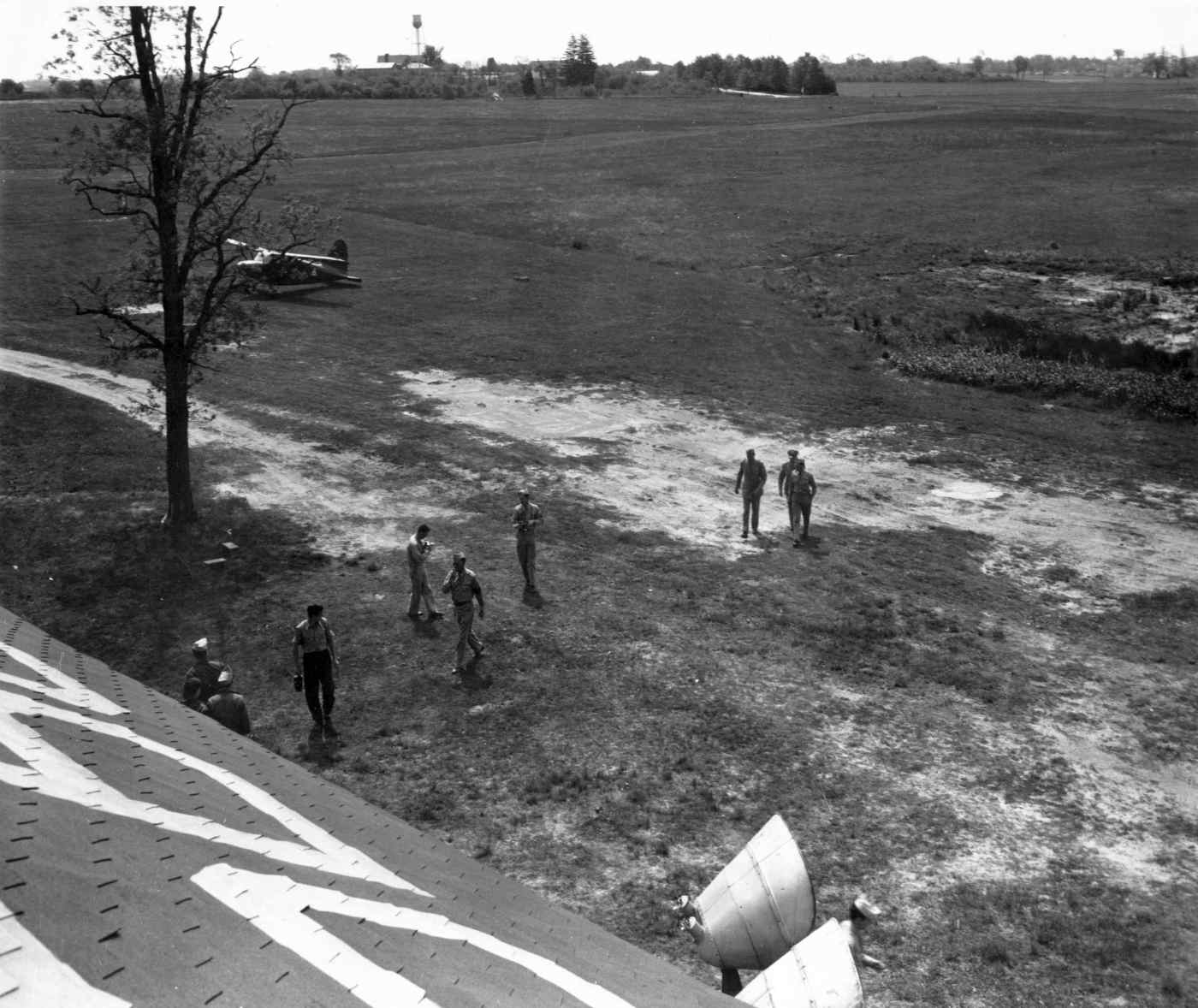
A mid-to-late-1940s photo by Don Reid (courtesy of Bruce Reid) at Asbury Air Terminal.
Bruce Reid observed, the photo is “from AAT 'Control Tower' looking toward the Jumping Brook Golf & Country Club.”

A mid-to-late-1940s photo by Don Reid (courtesy of Bruce Reid) of the Asbury Air Terminal flightline. Showing several Stearman biplanes.
George Baczkowski recalled “Asbury Park Air Terminal brought back great & happy memories of a rustic, old fashioned & friendly little field,
full of character & characters – not the least being Ike Sclossbach.
The Airfield, although known as Schlossbach Field was in the 1940s & 1950s called Jumping Brook (Air)Field.
The Jumping Brook being a spring that traversed the field & fed – underground – the pond, which never ran dry.”
The field had been renamed Asbury Park Air Terminal
by the time of the 1950 NY Sectional Chart (courtesy of Mike Keefe).
It was described as having a 2 unpaved runways, with the longest 2,350'.
Bruce Reid recalled, “Ike had 2 horses that could, at times, free-range on the airport grounds.
That is why that pond was dug (for the horses to drink from).
My sister Dorothy & I would ride, exercise & groom the horses on weekends in the early 1950s. Their names were King & Cactus.”
According to an article in the 10/4/51 issue of the Philadelphia Evening Standard (courtesy of John Bircher),
"Issac Schlossbach of the Asbury Park Air Terminal paid $1,560 for 6 individual airplane hangars",
at an auction of the assets of Philadelphia's Boulevard Airport, following its closure.
A 1957 aerial view depicted a new somewhat longer east/west runway which has been added at some point between 1947-57.

An undated photo of a taildragger being hand-propped in front of the Asbury Park Airport “office”.
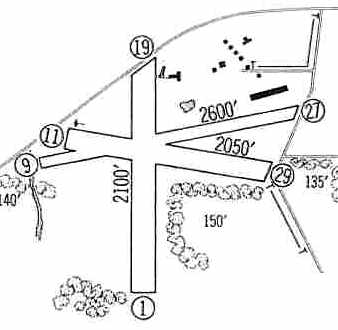
The 1959 Jeppesen Airway Manual (courtesy of Chris Kennedy) depicted the Asbury Park Air Terminal as having 3 unpaved runways,
with the longest being the 2,600' Runway 9/27.
A long T-hangar was depicted on the northeast side of the field, along with a number of smaller buildings.
George Baczkowski recalled “As the airfield expanded in the late 1950s it took the title Asbury Park Air Terminal.
The terminal, as Ike told me, was in fact the first 2-floor chicken house in the USA, converted to ‘civil’ use!
On a hot summer’s day, its past history could be sensed.”
Undoubtedly the most unusual vehicle operated from Asbury Park Air Terminal was the Reid “Flying Submarine” RFS-1.
Bruce Reid recalled, “My dad was manufacturing patented radio controlled model submarines as a business
when a set of model airplane wings accidentally fell from a shelf across the hull of one of them in his basement workshop.
Dad looked at it for a moment & asked 'Why not, - why not a flying submarine?'
That was the birth of an idea that 'consumed' the rest of his life.
Why, and for what purpose (as did ask Henry Morgan of my father on stage of the national TV program 'I've Got a Secret').
If you may remember the Cold War, a flying submarine in the hands of an enemy power could have approached our shores without ever being detected by radar!”
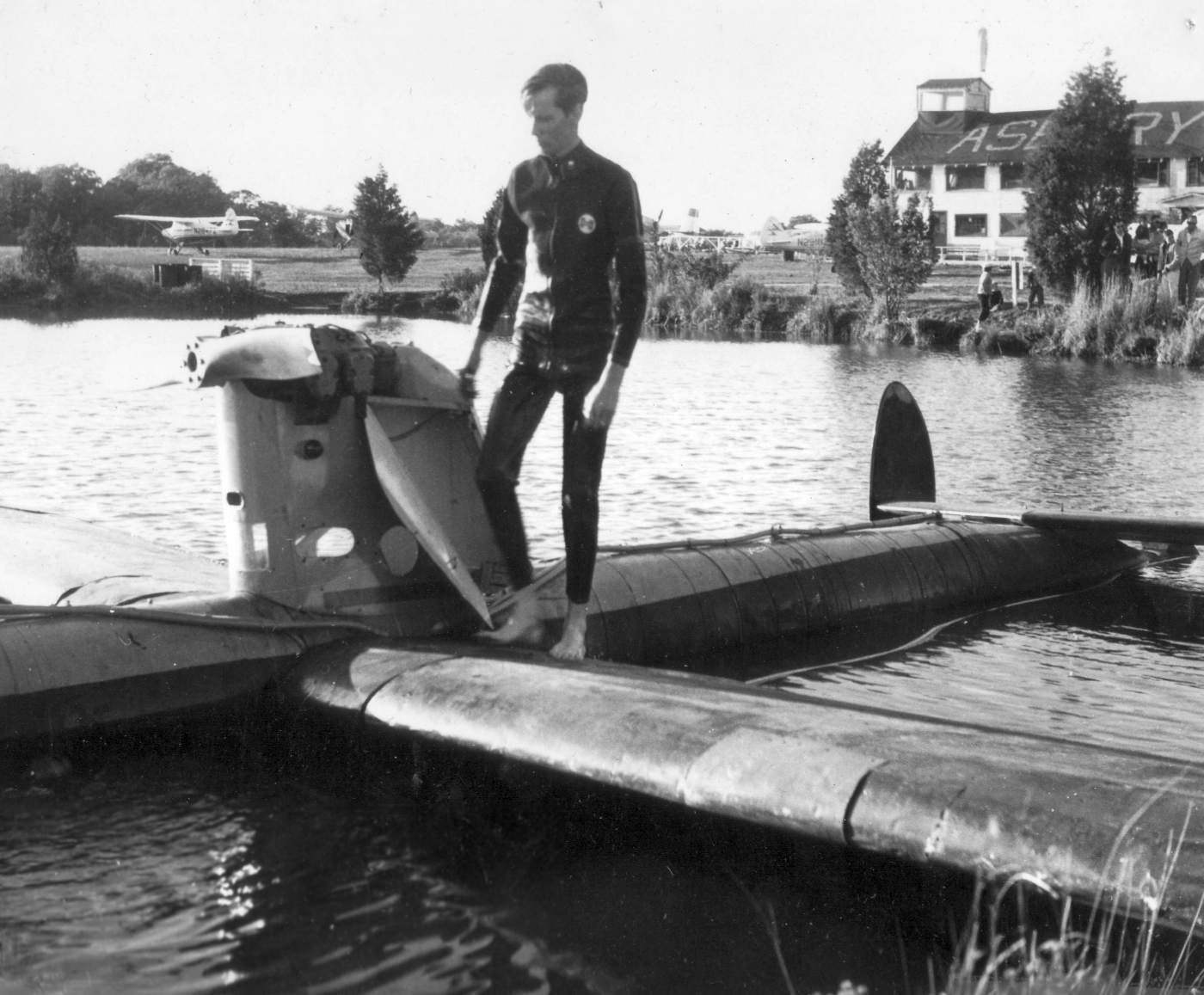
A 1961 photo of Bruce Reid entering the Reid RFS-1 Flying Submarine in the Asbury Park Air Terminal pond (courtesy of Bruce Reid).
Bruce Reid recalled, “I was the pilot of the Flying Sub! Flying Sub tests at the airport began during the summer of 1961.”
George Baczkowski recalled, “A converted Forney Aircoupe, it was tested in the pond.”

A 1961 photo of the Reid RFS-1 Flying Submarine in the Asbury Park Air Terminal pond (courtesy of Bruce Reid).
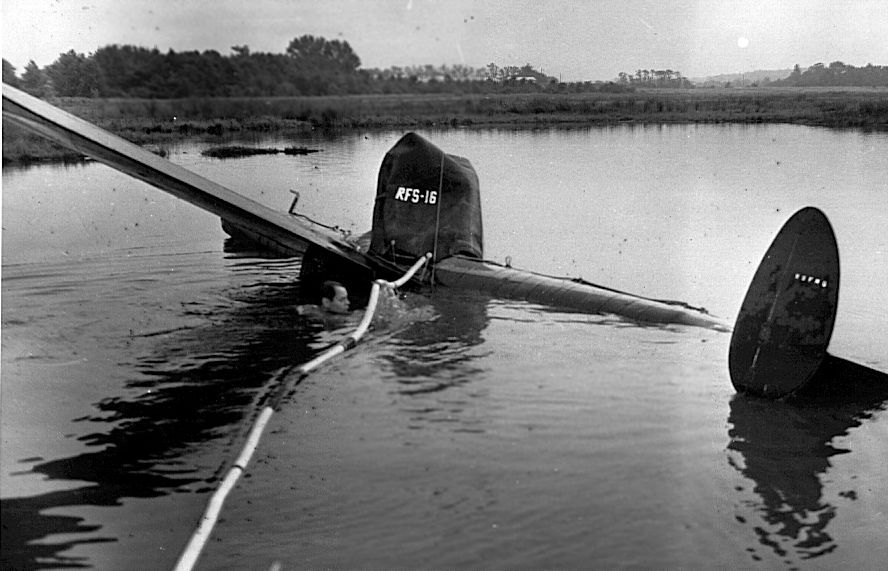
A 1961 photo of the Reid RFS-1 Flying Submarine in the Asbury Park Air Terminal pond (courtesy of Bruce Reid).
Bruce Reid recalled, “FS suffered an air supply line failure which was repaired within moments & resurfaced under complete control.”

An undated (circa 1960s?) aerial view by Dick Lewis looking north at Asbury Park Air Terminal.
Dick observed, “Note that the East-West runway is unpaved (mostly) and other areas appear undeveloped.
I instructed there during that time period & also was part of the 'Jersey Aero Club' & the 'Asbury Air Terminal Sky Divers' club.
Bruce Reid recalled, “I started flying at Asbury Air Terminal on 6/3/62 in my friend's Aeronca Chief with highly known & respected CFI Lou DeFasio.”
The 1962 AOPA Airport Directory
described Asbury Park Neptune Air Terminal as having a 3,000' gravel runway (9/27) & a 2,500' grass runway,
and the operators were listed as Isaac Schlossbach & Edward Hall.
A 1963 aerial view depicted Asbury Park as having 3 unpaved runways.

A circa 1960s photo of Guy Aliotta in front of an air taxi Beech Bonanza at Asbury Park Airport (courtesy of Tom Aliotta).
Tom Aliotta recalled, “He was Vice President & Chief Instructor at Aero Knights Inc.”
Richard Kenyon recalled, “Asbury Park (Neptune) Airport... Dick Bach had a Fairchild restored by Ike Schlossbach at that airport many years ago,
and the account of it was written up in Flying Magazine, probably in the early to mid 1960s.
There was also a P-51 & F-8 based there, and it was an audible & visual treat when these great birds landed or took off.”

A 1965 photo by Emmett Francolis of the Asbury Park Airport “office”, with a Twin Beech in front.
Emmett Francolis recalled, “In 1964-1965 I was leaning to fly at Asbury Park Airport.
At the time I was working for The Reader's Digest in New York but I lived in Teaneck, NJ.
Our life-long friends moved to Neptune & while we were there I visited the airport
and found a Model A Ford coupe in need of restoration.
After approaching Ike Schlossbach I offered to help with the restoration if he would teach me to fly.
He had 2 instructors who were brothers that did the flight instruction: Donald & William Leefe.
The planes they used to teach with were Aeronca 70C & 7AC's.
Commuting between Teaneck & Asbury Park did not leave a lot of time to do the restoration work & also get in some flying time.
We did get the old Model A up & running and even got to give it a coat of primer before I had end my flying lessons.
I do remember the banner fliers keeping a frequent schedule while I was working there.
One flier owned a Bearcat.
The propeller on that single engine plane was huge
and he remarked how he could not afford to fly it much since it consumed so much fuel.”

A photo by Emmett Francois “of a Stearman that was at the Asbury Park Air Terminal while I was flying out of there in the 1960s.”
The 1965 NY Sectional Chart (courtesy of John Voss)
described Asbury Park Neptune as having 3 turf runways, with the longest being 3,000',
but the remarks included "NW/SE runway closed".
Chuck Maire recalled, “My first flight instructor job was with Billy Gibson at Asbury.
I met Ike there who lived at the airport in a small house with one light bulb & no water to speak of.
The flight school was not much better in that regard.
To say it was a colorful airport was an understatement.
I towed banners for a couple of seasons while in college there.
I could tell stories that you would find hard to believe about that place.”
George Baczkowski recalled, “An article on Asbury by James Gilbert was published in Flying Magazine 1966/67 under the title ‘The One Horse Airport’
with the opening ‘Beneath its untidy ramshackle exterior there beats a heart of gold.’ Yes – 100%!”
"Ike" Schlossbach owned & operated the airport until approximately 1966-67,
when he leased the operation to Dick Davis, a local auto dealer & avid pilot.
In Rich's words, "The runway was paved sometime between September 1965 & January 1966.
I had taken lessons & soloed there on the 'grass' (gravel) runway in August 1965,
and at the end of the month I went off to college.
When I came back to NJ for the semester break over the Christmas holidays the runway had been paved."
According to pilot Ed Drury, during rainy periods,
the pond adjacent to the north side of the runway would overflow & flood the runway.
Skydiving operations were conducted at Asbury Park.
George Baczkowski recalled “In 1968-71 I was a flight instructor with Bill Gibson in his Gibson’s Air Academy -
having landed the job in exchange for stripping his P-51 - N5412V of its old white paint.
Also at the field in the late 1960s was an air taxi operation - Piper Twinnair - operating PA-30s, PA-23s, and 2 of the prototype PA-31 Navajos.
The name came from one of the directors (Tom Hartford?) who married Piper’s daughter.”
According to Ray Lewis, his cousin Carl Lewis worked at Asbury Park in the late 1960's & early 1970's
attaching banners to be trailed by small aircraft up & down the beaches.
The banner towing operations were later moved to Allaire Airport after Asbury Park closed.
"Asbury Park Neptune" Airport was depicted on the 1969 USGS topo map.
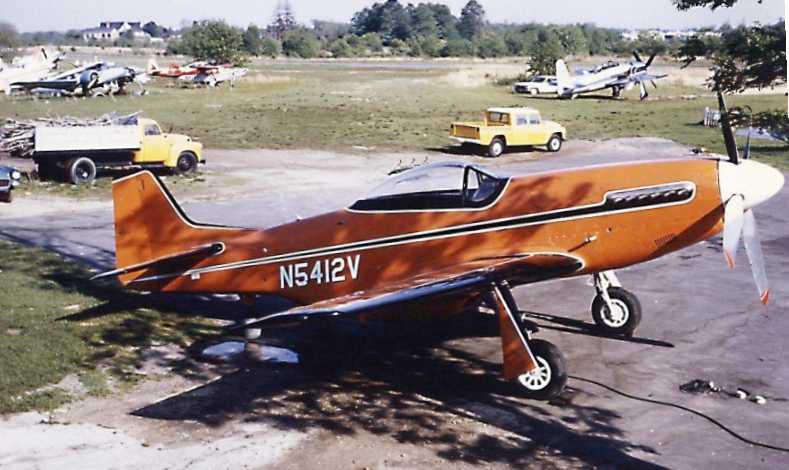
A 1969 photo by George Baczkowski of a beautiful P-51D Mustang at Asbury Park Neptune Air Terminal,
with a Grumman F8F Bearcat & other aircraft in the background.

A beautiful 1969 aerial view of George Baczkowski flying Bill Gibson’s Ryan PT-22 over Asbury Park Air Terminal (courtesy of George Baczkowski).

A May 1969 photo by Chester Christopher of a F8F-2 Bearcat taking off from Asbury Park Neptune Air Terminal,
with the landing gear caught in mid-retraction.

The last aerial photo which has been located depicting Asbury Park Airport while still open was a 1970 aerial view.
It depicted Asbury Park as having a single paved runway,
and an unpaved north/south runway.
It appeared as if the 3rd (northeast/southwest) runway had been abandoned.
A total of over 45 aircraft were visible on the field.

The 1972 Flight Guide (courtesy of Chris Kennedy)
depicted Asbury Park as having a 3,000' paved Runway 9/27 & a 2,300' unpaved Runway 2/20.
A total of nine buildings (hangars?) were depicted on the northeast corner of the field.
The field was noted to have glider activity.

The last photo which has been located depicting Asbury Park Airport while still open was a circa 1972-73 photo
of N5216X, a 1969 Champion 7GCAA Citabria, serial #201.
Chuck Marie recalled, “Billy Gibson ran the flight school at the Asbury Airport.
He gave me my first job as a flight instructor at the Asbury Airport in 1973.
Ike Schloshbach owned Asbury Park Airport & lived at the field when I instructed there.”

Asbury Park Neptune was still depicted as an active airport
on the 1975 NY Terminal Area Chart (courtesy of Mike Keefe),
although the field's name was misspelled, as "Ashbury Park".
It was depicted as having a 3,000' paved runway.
Asbury Park Neptune Airport closed in 1977.
Emmett Francolis remarked, “The story about the airport closing is a familiar one.
General aviation has shut out many who wished to learn how to fly because of taxes
and people who build around an airport & then complain about the noise.”
In a 1996 report by the New Jersey General Aviation Study Commission's Subcommittee on Airport Closings,
reasons were given for the closing of 13 New Jersey general aviation airports.
According to the report, taxes at Asbury Park Airport rose more than 600% from 1966-1972,
climbing from less than $6,000 to $36,000.
On the 1986 USGS topo map, the runway was still depicted, but unlabeled.
On the 1989 USGS topo map, nothing at all was depicted at the site of the field.
The airfield was not depicted at all (even as an abandoned airfield) on recent aeronautical charts.
Since the airport's closure, 2 commercial buildings have been constructed
along the northern portion of the airport property, fronting Route 66.

A 3/28/95 USGS aerial photo showed that most of Asbury Park's Runways 9/27 & 2/20 still existed.
Closed runway "X" markings were still visible along the middle portion of the Runway 9/27.
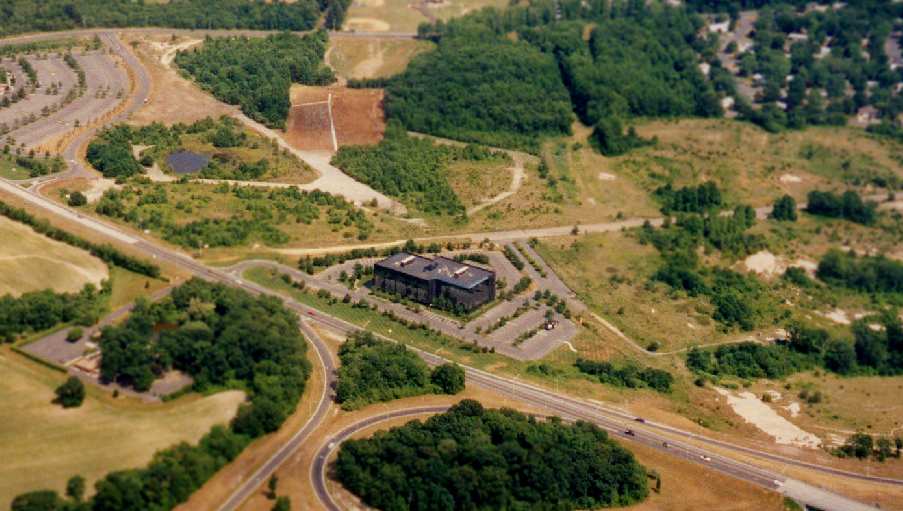
A 1997 aerial view looking south at the remains of Asbury Park Airport by Philip Kineyko.
A later aerial photo from 2001 confirmed that the runway still existed in the same state.
Tom Rutherford reported in 2005, “It looks like they are going to build an upscale mall
on that site some time in the next year or two.
The shopping malls are popping up all over that area.
So far they have build a huge WalMart & Home Depot in the area & there are talks of this new mall.
The runway is still there.”
William Angus reported in 2005, “Asbury Park airfield is still there,
though locals with ATV have carved numerous trails into the woods & the property is up for sale.
There are 3 construction vehicles on site
and certain sections (very small sections) appear to have been leveled like a lawnmower.
Also something very strange was that some trees were being dug up & their roots wrapped,
as if they were going to be sold or transplanted elsewhere.”

A circa 2006 aerial view looking east showing a section of the Runway 9/27 pavement which remains intact at Asbury Park.

A circa 2009 photo looking along the remains of the Asbury Park Runway 9/27 pavement.

A 9/26/13 aerial photo showed that Hovchild Boulevard had been built over the alignment of Asbury Park's Runway 2/20.
The end for the remains of Asbury Park Airport appeared to come in 2014,
when Matt Treharne reported, “Someone has clearly bought the land & is clearing it of all trees to construct something.”
Bruce Reid reported in 2015, “The Flying Sub [tested in 1961 at Asbury Park] is now at the Mid Atlantic Air Museum in Reading, PA.”
The site of the Asbury Park Airport is located
southeast of the intersection of the Garden State Parkway & Route 66.
____________________________________________________
Colts Neck Airport (N61), Colts Neck, NJ
40.278, -74.182 (South of New York, NY)

A circa 1946-49 photo by Don Reid of an airshow at Colts Neck Airport (courtesy of Bruce Reid),
with a Navy blimp coming in over the hangars, aircraft, and a truck-mounted radar.
According to "Colts Neck: A brief history" (from the 10/18/01 issue of the Asbury Park Press),
the Colts Neck Airport was built in 1938.
However, no airport at Colts Neck was depicted on the 1945 NY Sectional Chart.
The earliest depiction which has been located of Colts Neck Airport was a circa 1946-49 photo by Don Reid of an airshow at the little airport (courtesy of Bruce Reid),
showing a Navy blimp coming in over the hangars, aircraft, and a truck-mounted radar.

A 1947 aerial view depicted Colts Neck as having 2 grass runways, with 3 hangars just north of the runway intersection.
No aircraft were discernible on the field.
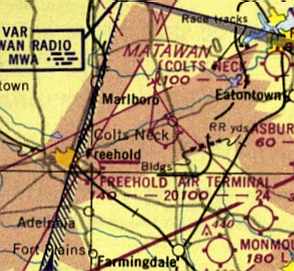
The earliest aeronautical chart depiction of Colts Neck Airport which has been located
was on the 1950 NY Sectional Chart (courtesy of Mike Keefe).
It depicted Colts Neck as having a 2,400' unpaved runway.
Pat Faley recalled of Colts Neck Airport, "The Airport was located west of NJ State Highway 34,
just south of Monmouth County Route 537
and just north of NJ State Highway 18 (which was still under construction when the airport closed).
The only entrance to the airport was off of Route 537
and required a drive down a dirt road & a stop sign to cross a runway to get to the hangar/office area.
There were 2 grass runways in a standard cross formation, both around 3,000'.
While I can't remember the owner's name,
I do remember that he had his 1st pilot license hanging in the office.
It was signed by Orville Wright."
J.H. Cubbage recalled, “When I was very young (1952?), I visited my Uncle Bill at the Colt's Neck airfield.
He was a pilot & I think he was serving as a manager.
I remember there was a cold soda chest in front of the office & I drank a strawberry soda.
Soda bottle caps were on the ground.
I remember someone talking about a flying license signed by a Wright brother hanging on the wall of the office.”
The Colts Neck was not yet depicted at all on the 1954 USGS topo map.
A 1957 aerial view depicted Colts Neck in the same manner as the 1947 aerial view.
A single light aircraft was visible on the northwest/southeast runway.
A significant increase in usage was apparent on a 1963 aerial view,
in which a total of 12 light aircraft were visible parked along the north side of Colts Neck Airport.
Chuck Maire recalled, “I was a line boy at Colts Neck Airport.”

The 1968 Flight Guide (courtesy of Robert Levittan) depicted Colts Neck Airport as having 2 unpaved runways: 2,400' Runway 6/24 & 1,350' Runway 14/32,
with 3 small buildings northeast of the runway intersection.

A 1970 aerial view depicted Colts Neck Airport perhaps at its zenith of popularity,
with a total of 26 aircraft visible parked on the northeast side of the field.
Kevin Smith recalled, “I flew for the first time out of Colt's Neck, and Paul Willy was the instructor.
'Ramshackle' was one way to describe the place.”
Keith Botts recalled, “Colt's Neck... I was stationed at Ft Monmouth in 1978-79 & did some of my earliest flying there.
The airport manager (I believe he was also the owner) was Paul Wirth.
He had a beater Cessna 150 that you had to start by pulling a handle out of the panel.
That closed the contactor on the starter. It had radios, sort of.”
Keith continued, “Flying was a trip. The runway was always rough, sometimes muddy.
Takeoff started at the (usually) east end of the main east/west runway with 10 degrees flaps,
you pulled the yoke half back, firewalled the throttle with the brakes locked, and let it go when it stabilized.
Bounce down the runway, front wheel about 6 inches off in 20 feet,
drive down the runway that way until the airspeed needle looked like it was going to move slightly, and it lifted off in ground effect.
Nose slightly down, gain airspeed in ground effect and then to Vx to clear the junk at the end.
Flaps in, turn to pattern, go around & land the same direction with full flaps, just above stall with the nose up & some throttle.
If you didn't do it that way, it would sink your floating kidney during the ground roll & Paul would chew your butt for beating up his airplane.”
Keith continued, “I did my first solo cross country Colts Neck – Millville - Atlantic City - Colts Neck.
The guy who came out to sign my logbook said 'You're from Colts Neck, aren't you?'
The airplane was covered with mud from the strut attach to the stabs. You couldn't even read the tail number.”
Keith continued, “Takeoff from the north/south runway went over Naval Ammunition Depot, Earle on the South end if you went too far.
That was a Restricted zone, although they didn't get too excited about it.
They had Paul's phone number, though (a black phone extension off the pay phone on the front of the FBO).”
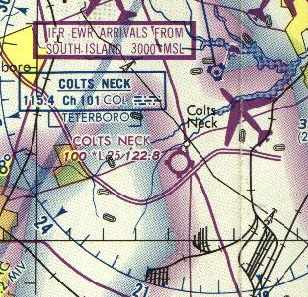
The 1979 NY Terminal Area Chart depicted Colts Neck as having a 2,500' unpaved runway.
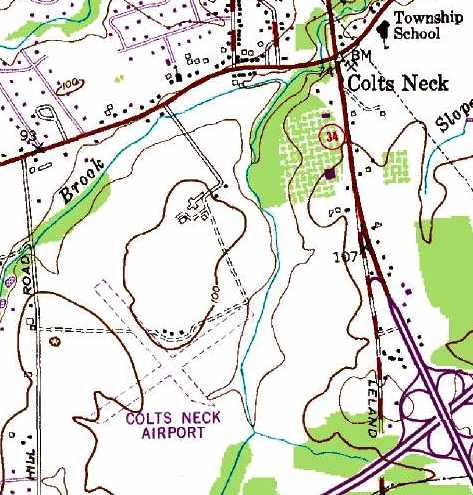
The 1981 topo map depicted Colts Neck Airport as having 2 unpaved runways,
with a cluster of small buildings north of the runway intersection.
Mike Pilla recalled, "I towed gliders from a roughly 2,400' grass strip in Colts Neck.
We used a Cessna 150 with a 150 hp engine & had to consult a density altitude chart
plus minimum wind and/or maximum x-wind component chart before towing activities on any day could commence.
During most of the summer, towing was limited to single place ships,
sometimes 2 place ships flown solo, rarely dual.
Training a new tow pilot, in the hot & humid summer was impossible.
If the density altitude exceeded about 3,500', there was no towing at all."
Craig "Red" Heun recalled, “Colts Neck Airport... I got my private there on June 3, 1983 with Tom Ford as my instructor.
The FBO was run by Paul Willy.
There was banner towing (using mostly Bird Dogs), glider flying, and sometimes in the evening & morning hot air balloons.
It was a great place to learn & had the 'old time' airport feel. Absolutely nothing fancy about it.
As I recall the roof in the office leaked, had a wood stove for heat & nothing that could be considered running water.
I have been all over this country & seen many airports, but I fondly remember Colts Neck as a real airport.
It was in the middle of a corn field, taught you the hard facts about the use, or misuse, of ground effect
as well as how to divide you attention between flying final & the surrounding environment which often included deer & geese.
I got my first biannual with Ed Burke at Colts Neck so many years ago.”
Rich Peabody recalled, "When I moved here, 1984, I stumbled upon an airport in Colts Neck…
a grass field with about 30 based aircraft, and an additional 10 soaring ships.
There was a row of T-hangars & a conventional hanger that housed a Stearman in incredibly rough condition
that I bartered a ride in from the kid that seemed to be the FBO / instructor / glider tug guy."

The last aeronautical chart depiction which has been located of Colts Neck Airport
was on the June 1985 NY Sectional Chart (courtesy of Mitchell Hymowitz).
It depicted Colts Neck as having a 2,500' unpaved runway.
Pat Faley recalled, "As Colts Neck became a very exclusive & pricey town to live in
(million-dollar estates, horse farms, and 5 acre zoning),
there was no place for the airport. Very Sad."
Bill Bienes was employed at an aircraft repair shop at Colts Neck Airport up until the point of its closing.
"I left that place with tears in my eyes the day it closed", he said.

An undated photo of a Piper Cub inside a Colts Neck hangar.

A circa 1987-88 aerial view by Ed Burke looking north at Colts Neck Airport.

A circa 1987-88 photo by Ed Burke of a few Cessnas in front of the hangars at Colts Neck Airport.
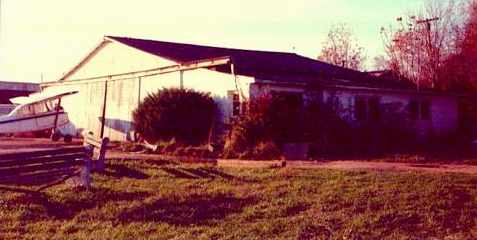
A circa 1987-88 photo by Ed Burke of a hangar at Colts Neck Airport.

A circa 1987-88 photo by Ed Burke of a hangar at Colts Neck Airport.
Adam Rosenberg recalled, "I got my Private Pilot License in 1987 May
and continued to rent airplanes until 1988 August when Colts Neck Airport was finally shutting down
after decades of pressure from real estate developers.
Colts Neck Airport has been turned into a housing development of all-the-same McMansions on tiny plots of land."
Adam continued, "The joys of a small airport are hard to describe to somebody who has not spent time at one.
Colts Neck Airport, once known in the registry of the Federal Aviation Administration as N61,
was about small, simple airplanes & people flying them.
I believe I was the last person who learned to fly there.
My solo date was December 7, 1986."
Adam continued, "N61 was in Colts Neck, an upscale community in Monmouth County,
close enough to the beach to be considered part of the Jersey Shore.
The forces of housing development finally won the war
against the desires of a few old, moldy pilots & it closed a few years ago.
But N61 lives on in our hearts."
Adam continued, "N61 was 2 runways & a seriously-beat-up hangar & office.
The hangar door had enough gaps to let the pigeons inside,
so covering the wings with a tarp was a part of N61 indoor parking.
Most airplane owners took their chances outside with the occasional snow.
The runways were rutted with enough gaps in the grass that its Yahoo group calls itself MuddyRunways.
The usual runway, 25, was 2,500' long with bushes & cornfields at the ends.
An expertly done short-field landing there was rewarding with a little flick sound of cornstalks brushing against the wheels.
Every runway roll, take-off or landing, had a bumpity-bump-bump feel
as the airplane rolled & hopped over the ruts in the runway."
Adam continued, "The FAA database said we had a Unicom radio frequency (122.8),
but nobody on the field ever listened to it,
and they said we had fuel, but no pilot I know trusted it to have more gasoline than water.
Colts Neck Airport was not about luxury in flying."
Adam continued, "The L-19 pilots used to cut toilet paper in the air.
The idea was simple: One would nick a roll from the bathroom (and the owner always wondered where it went so quickly),
throw it out the window of the airplane,
and try to cut the stream as many times as you could before the toilet paper (or the airplane) hit the trees."
Adam continued, "My favorite part of Colts Neck Airport life was Octoberfest.
We would all get together the 1st nice weekend in November,
always early November because pumpkins (which we called 'punkins' in New Jersey) were cheap right after Halloween.
We would load up our L-19 Bird-Dogs & Cessna 150s & Luscombes & Cubs & try to hit a pre-designated spot in a field."
Adam continued, "Colts Neck Airport may be gone, but the skies will never be totally sane & stodgy so long as we're still up there."
In a 1996 report by the New Jersey General Aviation Study Commission's Subcommittee on Airport Closings,
reasons were given for the closing of 13 New Jersey general aviation airports.
According to the report, "At Colts Neck Airport, the corporation which bought the land for development
and then decided not to proceed because of a downturn in the economy
closed the airport on the advice of lawyers who recommended the action because of alleged exposure to liability."
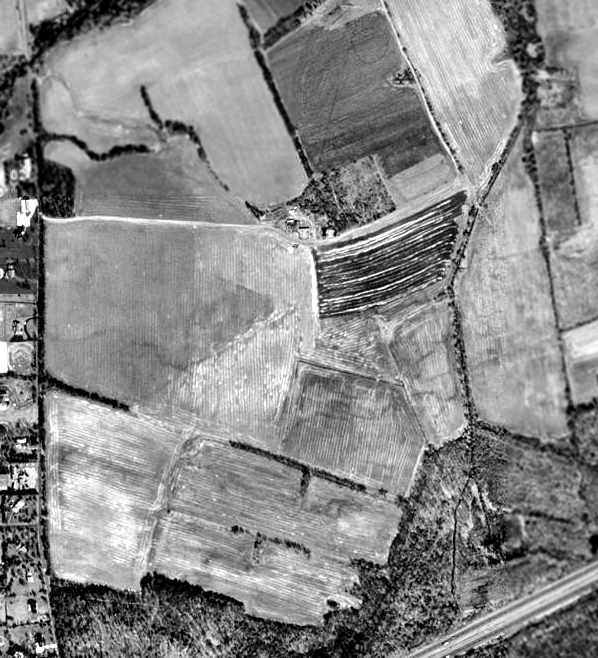
As seen in the 1995 USGS aerial photo, the site of Colts Neck Airport was still open & not yet redeveloped,
but the outline of either runway was no longer recognizable.
It appeared as if the hangars still remained intact, though.
According to the 1996 report by the NJ General Aviation Study Commission's Subcommittee on Airport Closings,
"That land is still vacant."
That status of the property apparently didn't last too long,
as William Angus reported in 2005, “Colts Neck airfield is completely gone... it is nothing but McMansions.”

A sad 9/6/13 aerial photo showing a golf course community covering the site of Colts Neck Airport.
Craig "Red" Heun recalled, “Maybe it's fantasized nostalgia, but I look at one of those painting/prints sold through Sporty's or The Wright Brothers catalogs
of the J3 sitting in front of an old hangar on a farm, it reminds me of that once magic place, in the once 'Garden State' known as Cots Neck Airport.
It's a shame the developers won the war in the destruction of Colts Neck.
I guess condos of the pseudo-rich take priority.”
The site of the former Colts Neck Airport is located south of the intersection of Route 537 & Route 34.
____________________________________________________
Red Bank Airport, Red Bank, NJ
40.327, -74.08 (South of New York, NY)

Red Bank Airport, as depicted on the 1930 "Rand McNally Standard Map of NJ With Air Trails" (courtesy of Chris Kennedy).
According to the book "Tinton Falls" (via Douglas Wright),
Red Bank Airport was built in 1926 by Air View, Inc., on part of the George Hance Patterson farm.
Jack Casey was the pilot for the company, which performed aerial photography.
The 1930 "Rand McNally Standard Map of New Jersey With Air Trails" (courtesy of Chris Kennedy)
described the Red Bank Airport as being operated by the Air View Flying Service.
The field was described as consisting of a rectangular field, measuring 2,700' east/west x 2,500' north/south.
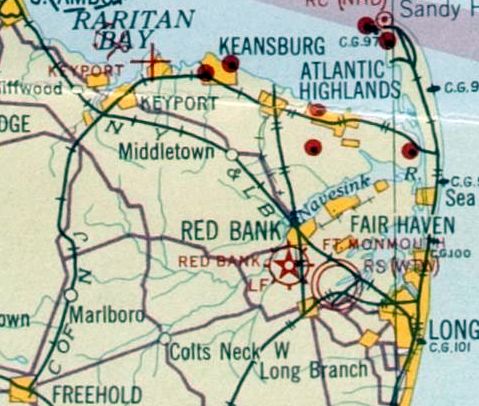
The earliest aeronautical chart depiction which has been located of Red Bank Airport
was on the November 1931 NYC-Albany Air Navigation Map.

A circa early-1930s aerial view of Red Bank Airport
depicted the field as a roughly square grass field, in the center of which was visible 2 airport circle markers.
The 1934 Department of Commerce Airport Directory (according to Chris Kennedy)
described Red Bank Airport as consisting of a 2,700' x 2,200' sod rectangular landing area.

A circa 1930s brochure for Red Bank Airport's Airview Flying Service (courtesy of Tom Heitzman).

A circa 1930s photo of an unidentified monoplane of Airview Flying Service being loaded in front of Red Bank Airport's hangar & beacon tower (courtesy of Tom Heitzman).

An aerial view looking northeast at Red Bank Airport,
from the Airport Directory Company's 1937 Airports Directory (courtesy of Bob Rambo).
The directory described Red Bank Airport as consisting of a 185 acre rectangular sod landing area.
The aerial photo in the directory depicted a single hangar at the corner of the field.
Richard Marlin recalled, “Red Bank Airport... Walter Laudenslager came to the airport in 1938 & ran a charter & flight school.”

A 1941 street map (courtesy of Douglas Wright) shows how tightly the airport property was situated,
as a total of only 77 acres contained 2 runways, oriented east/west & north/south.
Richard Marlin recalled, “When the 2nd world war started, [Walter Laudenslager] signed with Monmouth Junior College in West Long Branch
to start a civilian pilot training program with the U.S. Government.
When the government took over the airport they painted over the name on the hangar & moved the CPT program to Red Bank Airport.”

1/1/46 photo by Calvin Burdge of his Waco in front of a Red Bank Airport hangar (courtesy of Charles Burdge).

A series of 1946 photos of Red Bank Airport by Donald Orndorf.

A circa 1946/47 brochure for Red Bank Airport (courtesy of Tom Heitzman).
Red Bank Airport had some early military use,
as the Army's Communications-Electronics Command (CECOM) Flight Activity
was located at Red Bank Airport after WW2, before being moved to Allaire airport.
The 1947 USGS topo map depicted an aeronautical beacon at the site of Red Bank Airport,
but did not depict the airport itself.
A 1947 aerial view depicted a dozen light aircraft parked around a single hangar on the northeast side of Red Bank Airport.

Red Bank Airport, as depicted on the 1950 NY Sectional Chart (courtesy of Mike Keefe).
A small charter & commuter airline firm, Air Taxi, began operations from Red Bank in 1950.
Air Taxi was run by Jim Loeb.
They offered commuter flights to Newark & JFK.
Richard Marlin recalled, “Red Bank Airport... I started flying there in 1951 & got my private license on a J-3 Cub.
At that time it was owned by Walter Laudenslager.”

The 1953 USGS topo map depicted Red Bank as having 2 unpaved runways
with several buildings & a beacon on the northeast side of the field.

The 1960 Jeppesen Airway Manual (courtesy of Chris Kennedy)
depicted Red Bank as having 2 unpaved runways (2,600' Runway 8/26 & 2,400' Runway 17/35),
with 2 buildings on a ramp on the northeast side of the field.
Bill Salisbury recalled, “I worked for Jim Loeb at Air Taxi Company in 1960 & early 1961 as a pilot.
I flew Beech Bonanzas, a Debonair, and Piper Apaches & an Aztec.
We put in some very long hours & often pressed the weather more than we should have.
I have a lot of fond & some no-so-fond memories of working there.
There used to be a restaurant & bar right next door to the airport, facing Shrewsbury Avenue, I believe it was called the Airport Inn.
They had some of the best hamburgers one could imagine.
We often ate there when time permitted.
I was a young guy of 23 years old & lived in an apartment on Bridge Avenue with my new, young wife.
Often times, coming home from one of the 3 major airports in New York where we flew shuttle charters back & forth all day,
I would alert my wife that I would be coming home for dinner soon,
by flying low over the apartment & putting the prop into low pitch as I passed over.
Then, I would pull up & land at the airport, put the airplane to bed for the evening, do my paperwork & head home.”
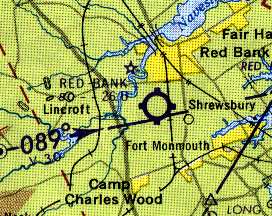
Red Bank Airport, as depicted on the 1961 NY Local Aeronautical Chart (courtesy of Mike Keefe).

An undated photo from a September 1962 article depicted a Beech Bonanza in front of Red Bank Airport's distinctively-styled terminal building.
Red Bank was listed among active airfields in the 1962 AOPA Airport Directory,
with 2 turf & gavel runways (the largest being 2,700' long),
and the operator listed as Red Bank Airport Inc.
A 1963 aerial view depicted a dozen light aircraft parked on the northeast side of Red Bank Airport.
It also showed that 2 additional hangars had been added at some point between 1957-63.
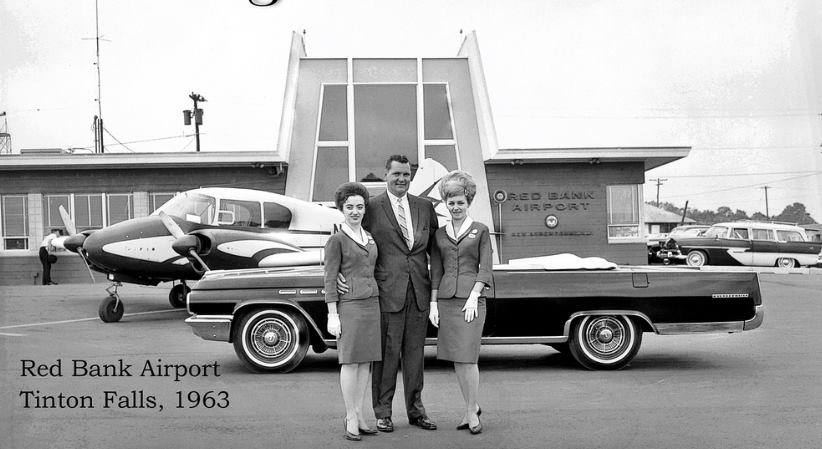
A 1963 photo of an unidentified group in front of a Piper Apache & Red Bank Airport's distinctively-styled terminal building (courtesy of Gary Fitton).

A 1964 photo of Santa Claus being flown by Guy Aliotta in a Bell 47 helicopter at Red Bank Airport (courtesy of Tom Aliotta).
Tom Aliottsa recalled, “Red Bank Airport... my father was a flight instructor there in 1964; he worked for Astro-Flight, Inc. based at the airfield.”
Jeff Owens recalled, “I took my first flying lesson at Red Bank in 1964.
I remember as a small boy going there when the end of the runway was a board fence made of 2 x 10
with only room to pull off of Shrewsbury Avenue for cars to watch activities.
I remember seeing C-47 (DC-3), and whatever the military Beech 18 is called, both of Army activities related to Fort Monmouth.”
According to pilot Ed Drury, the runway at Red Bank had a rise in the middle,
such that the opposite runway end couldn't be seen when positioned for takeoff.
Red Bank evidently gained a paved runway at some point between 1963-65,
as the 1965 NY Sectional Chart (courtesy of John Voss)
described Red Bank Airport as having a single 2,400' asphalt runway.
The remarks also said "North/south strip permanently closed."

Red Bank Airport, as depicted on the 1967 NY Local Aeronautical Chart (courtesy of Mike Keefe).
The 1968 Flight Guide (courtesy of Robert Levittan) depicted Red Bank as having a single 2,650' paved Runway 9/27,
and a parallel taxiway on the north side.
A ramp & 3 small buildings were depicted on the northeast corner of the field.
Chuck Maire recalled, “I received my private pilots license at Red Bank Airport in 1969 from Lou Miller the local examiner.”

A circa 1970 aerial view looking southeast at Red Bank Airport (courtesy of Douglas Wright).
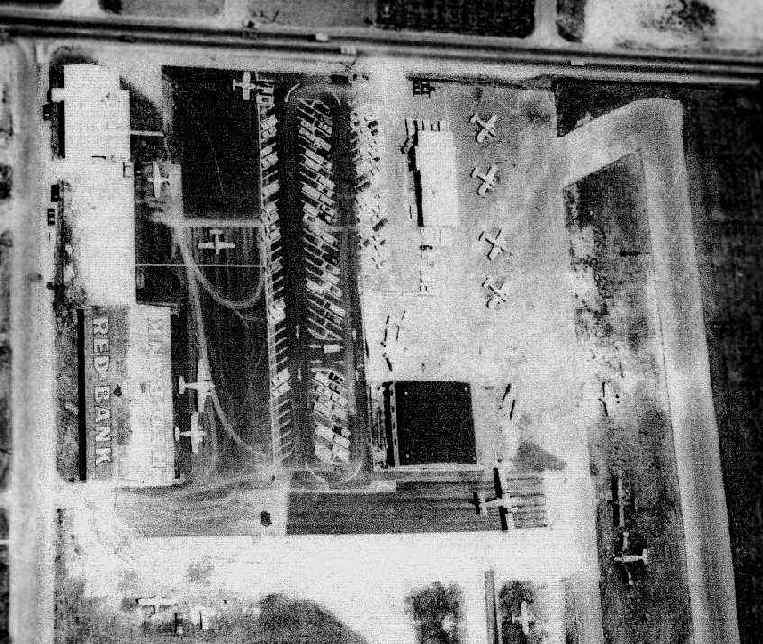
A circa 1970 closeup of the northeast corner of Red Bank Airport (courtesy of Douglas Wright).
In 1970, the airport was improved with the construction of a small terminal building for Air Taxi.
The newly paved Runway 9/27 ran to within a few feet of the street bounding either side of the airport property.

The January 1972 Flight Guide (courtesy of Chris Kennedy)
depicted Red Bank as having a single 2,650' paved Runway 9/27,
and a parallel taxiway on the north side.
A ramp was depicted on the northeast corner of the field, with a single building (a hangar?).
Patrick Faley recalled, "While Red Bank Air Taxi was the 1st scheduled passenger service out of the airport,
it was not the only or most successful service.
Reading PA based Suburban Airlines made Red Bank a sort of a hub for several years,
with service to JFK & Newark.
The airline flew both 9-seater Britton-Norman Islanders & 19 seat DHC Twin Otters.
After several fatal crashes at or near the airport,
including a Suburban crash that killed both crew & all 7 passengers,
the airport basically was forced to close."
In spite of the recent improvements in the airport's facilities,
Red Bank was closed at some point between 1972-79,
after suffering a string of accidents including the deaths of a couple of high profile local businessmen.
The resultant negative attention from the community, plus the increasing value of the land,
prompted the airport to be closed & the land redeveloped for commercial real estate.
By the time of the 1979 NY TCA chart (courtesy of Bill Suffa),
Red Bank Airport was no longer depicted at all (not even as an abandoned airfield).

The 1981 USGS topo map depicted the airfield as having a single 2,600' east/west runway.
Red Bank Airport was still depicted on the 1986 USGS topo map,
even though it had apparently been closed by that point for several years.
The 1995 USGS aerial photo showed that the site of Red Bank Airport had been redeveloped,
with several large office buildings covering the former airport.

A 2005 photo by Tom Rutherford of the remains of the taxiway at the site of Red Bank Airport
(note the remains of the yellow centerline stripe at the lower-left corner).
Tom Rutherford reported in 2005, “I work on the former site of the Red Bank Airport.
Unfortunately, approximately 5 years ago, a doctors office was built over the old section of the remaining runway,
though there is still a taxiway from the former airport but it is badly broken up.
You can easily tell that it is a taxiway because there are still yellow markings indicating the middle of the taxiway.”
Joe Strickland reported in 2006, “The terminal buildings were at the Shrewsbury Avenue end of the airport.
At this time there is a McDonalds, Gas Station, Rite Aid, and Wendy’s were the terminal was.
There are a few of the original building still there, although they have been heavily renovated.
These building are on the Apple Street side towards Shrewsbury Avenue.”
Steve Zaccaria reported in 2010, “What is now called the 'Pour House' restaurant on Shrewsbury Avenue
used to be the the Airport Inn, and was on the grounds of the airport for years!”

A 9/6/13 aerial photo showed several office buildings covering the site of Red Bank Airport.
Amazingly, a 600' long segment of the taxiway asphalt still remained visible in the bushes behind the parking lot of one building, in the center-right of the photo.
The site of Red Bank Airport is located southwest of the intersection of Shrewsbury Avenue & Apple Street.
____________________________________________________
Since this site was first put on the web in 1999, its popularity has grown tremendously.
That has caused it to often exceed bandwidth limitations
set by the company which I pay to host it on the web.
If the total quantity of material on this site is to continue to grow,
it will require ever-increasing funding to pay its expenses.
Therefore, I request financial contributions from site visitors,
to help defray the increasing costs of the site
and ensure that it continues to be available & to grow.
What would you pay for a good aviation magazine, or a good aviation book?
Please consider a donation of an equivalent amount, at the least.
This site is not supported by commercial advertising –
it is purely supported by donations.
If you enjoy the site, and would like to make a financial contribution,
you
may use a credit card via
![]() ,
using one of 2 methods:
,
using one of 2 methods:
To make a one-time donation of an amount of your choice:
Or you can sign up for a $10 monthly subscription to help support the site on an ongoing basis:
Or if you prefer to contact me directly concerning a contribution (for a mailing address to send a check),
please contact me at: paulandterryfreeman@gmail.com
If you enjoy this web site, please support it with a financial contribution.
please contact me at: paulandterryfreeman@gmail.com
If you enjoy this web site, please support it with a financial contribution.
____________________________________________________
This site covers airfields in all 50 states.